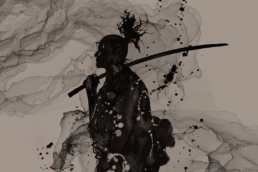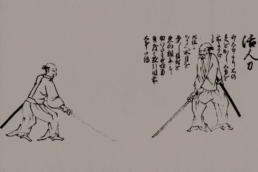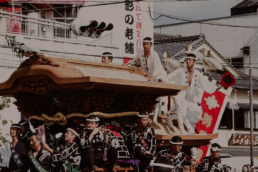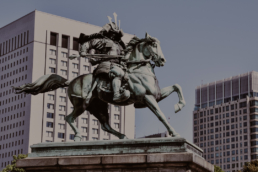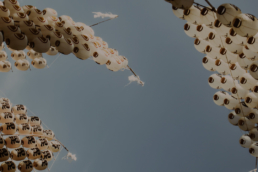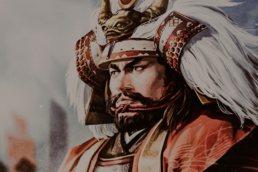Bushido: ethics and conduct, the way of the Samurai
Between the period of the Kamakura shogunate (1185) and the Muromachi period (1336) the code of moral conduct known as Bushido took shape (武士道, the path of the warrior). Formally adopted and applied by the "bushi", the warriors (Samurai) in the Tokugawa Period (1603-1867), this code of conduct is a re-adaptation of the principles of Buddhism and Confucianism. Originally adapted to the warrior caste, after the Meiji Restoration (1866-1869), the Japanese nationalist movement adopted by Bushido as a discipline of behavior.
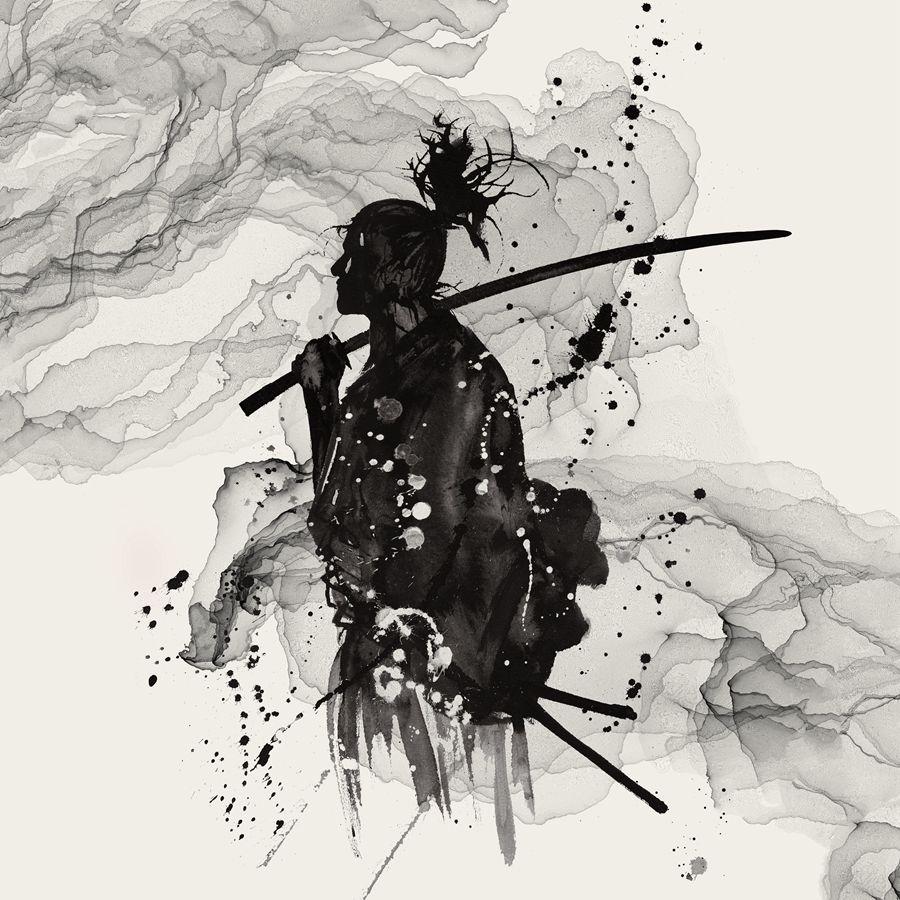
photo credits: camminospirituale.com
The 7 principles of Bushido: 7 steps towards perfection
Honesty, justice, piety, duty, honour, and loyalty were the principles that had to be pursued until death. If this were not followed, the penalty was the dishonour to be expiated through the seppuku (切腹) or harakiri (切り). Both of these terms indicate the ritual of honourable suicide through the cutting of the belly. Harakiri is used in speech, while seppuku is most used in writing.
Each Samurai was therefore required to follow 7 fundamental principles that we can define as "perfect morality".
Let's go into them and discover them together:
義, Gi: Honesty and Justice
There are no middle ways, there is only the right or the wrong. It is necessary to be honest in dealing with others, to believe firmly in the justice that comes from oneself, not from other people. The true Samurai never has uncertainties about honesty and justice
勇, Yu: Heroic Courage
The heroic courage of the Samurai rises above the masses. A warrior is not afraid to act, he does not hide in the shell like a turtle, despite the risk and danger. Heroic courage means to live completely, fully, wonderfully, it is not blind but strong and intelligent.
仁, Jin: Compassion
The intense training makes the samurai quick and strong. He is different from the others, he acquires a power that must be used for the common good. He possesses compassion, takes every opportunity to be helpful to his fellows and if the opportunity does not arise he does everything to find one. The compassion of a Samurai must be demonstrated above all in regard to women and children
礼, Rei: Kind Courtesy
The Samurai have no reason to behave in a cruel way, they don't need to show their strength. A Samurai is also kind to enemies. Without this demonstration of external respect, a man is little more than an animal. The Samurai is respected not only for his strength in battle but also for how he interacts with other men. The best fight is the one who is avoided.
誠, Makoto: Complete Sincerity
When a Samurai expresses the intention to perform an action, this is practically already accomplished, nothing will prevent him from completing the express intention. He needs neither to give the word nor to promise. Speaking and acting are the same thing.
名誉, Meiyo: Honor
The Samurai is the only judge of his honour. The decisions you make and the actions that follow are a reflection of what you actually are. You can't hide from yourself.
忠義, Chugi: Duty and Loyalty
For the Samurai to perform an action or to express something is to become its owner. He assumes full responsibility, even for what follows. The Samurai is immensely loyal to those he cares about. He remains proudly faithful to those for whom he is responsible.
For several years I myself have adopted these 7 virtues as a path to follow. I find them essential in everyone's life because we are all warriors. Every day we face challenges and every day we must aim for that spiritual perfection that, if pursued to the end, would lead to a better world.
Are you ready to take these steps?
Japan History: Yagyū Munenori
Yagyū Munenori (1571 - 11 May 1646) was a Japanese swordsman, founder of Yagyū Shinkage-ryū, one of two official sword styles sponsored by the Tokugawa shogunate (the other was Ittō-ryū).
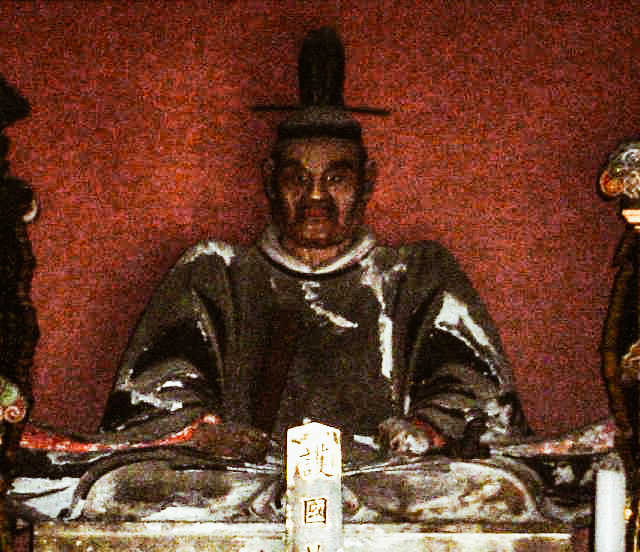
photo credits: wikipedia.org
He became a great expert in the fencing art thanks to a long almost monastic path dedicated to teaching in the Shogun family. It is in this place that we discover its true nature: guide and political adviser to three shogun and head of an "intelligence" body he created. Yagyū Munenori will lead Japan, in complete secrecy, for almost thirty years.
Yagyū Munenori's career
Munenori began his career in the Tokugawa administration as a hatamoto, a direct holder of the Tokugawa clan. Later his income was increased to 10,000 koku, making him a fudai daimyo, or a vassal lord in the service of the Tokugawa. Subsequently, Yagyū Munenori also received the title of Tajima no Kami.
Munenori entered the service of Tokugawa Ieyasu at a young age, and later became a sword instructor for Ieyasu Hidetada's son. He also became one of the main advisors of the third Igitsu shogun.
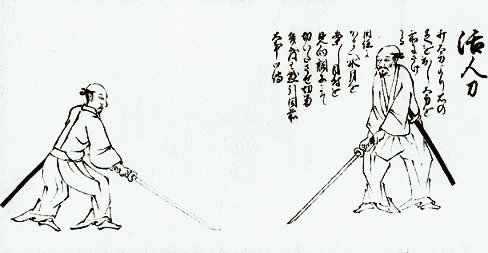
photo credits: doacademytorino.wordpress.com
Shortly before his death in 1606 he passed the guidance of Yagyū Shinkage-ryū to his nephew Toshiyoshi. After that, Toshiyoshi entered the service of a branch of the Tokugawa clan that controlled the province of Owari. Toshiyoshi's school was based in Nagoya and was called Owari Yagyū-ryū, while that of Munenori, in Edo became known as Edo Yagyū-ryū. Takenaga Hayato, the founder of Yagyū Shingan-ryū, was a disciple of Yagyū Munenori and received from him secret teachings (gokui) of Yagyū Shinkage-ryū.
Around 1632, Munenori completed Heihô Kadenshô, a treatise on Shinkage-ryū sword practice and how it could be applied to life and politics. The text is still in print today in Japan and has been translated several times in English. Translated into Italian: "The sword that gives life" it is a compelling biography of Munenori and a series of essays regarding sword techniques.
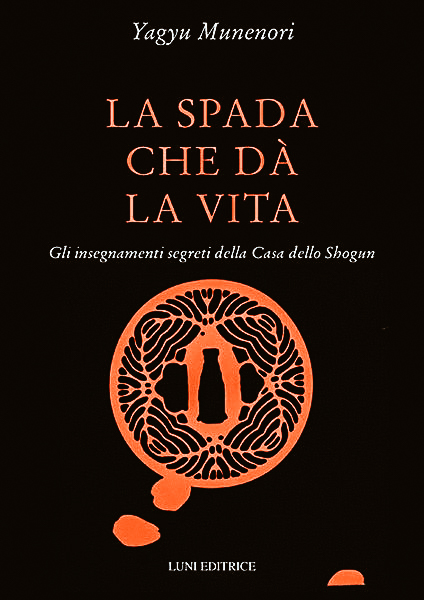
photo credits: www.lunieditrice.com
His sons Yagyū Jūbei Mitsuyoshi and Yagyū Munefuyu were also famous swordsmen.
Kitsunebi Matsuri, when folklore comes to life
In ancient Japanese folklore, the Kitsunebi (狐火, foxfire) was a yōkai that, overnight, suddenly appeared as a glowing red-orange and sometimes blue light. The Kitsunebi gradually increased to cover vast areas, reaching even 4km! It was believed that they were torches of a procession of foxes marching for their wedding. The lights were sighted by farmers in the mountains and were considered a good harbinger for the harvest. In fact, the greater the number of lights seen, the more fruitful was the harvest. However, no human was allowed to approach: those who tried were condemned to vanish.
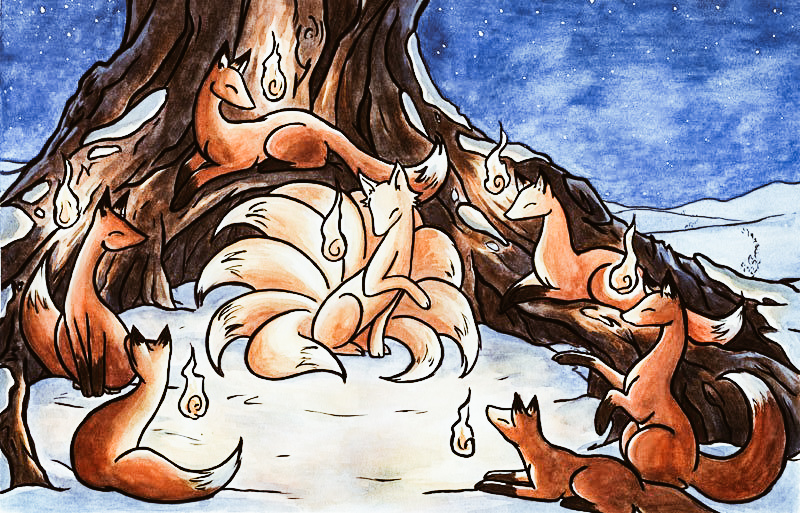
photo credits: tradurreilgiappone.com
In particular, the stories tell of the marriage between Otonosama, the king who lived in Furukawa, and Okon, the daughter of the fox God. This fascinating image is the origin of the Hida Furukawa Kitsunebi Matsuri (騨古川きつね火まつり). This festival is celebrated every year, on the fourth Saturday of September in Hida Furukawa, a picturesque and rural town full of beautiful landscapes, where even today you can breathe a life far from the frenzy of the metropolis.
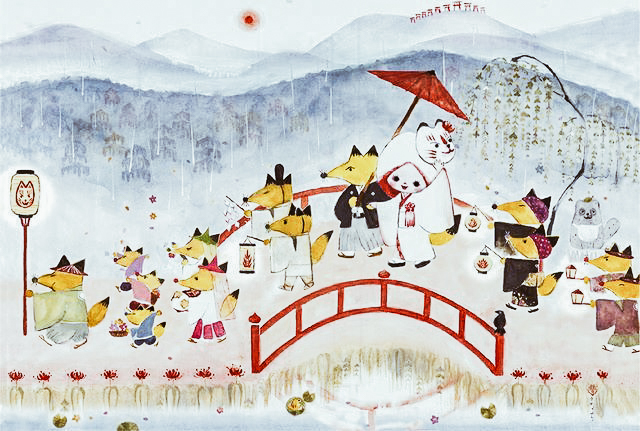
photo credits: tradurreilgiappone.com
Happiness and prosperity!
Like almost all the festivals we are used to now, the Kitsunebi Matsuri also aims to bless the harvest, happiness and prosperity for families.
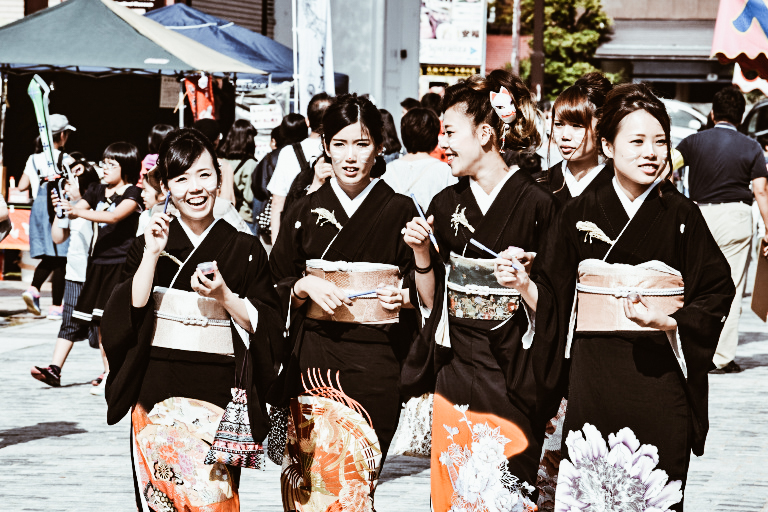
photo credits: myjapantravels.wordpress.com
But what exactly does the Kitsunebi Matsuri consist of??
First of all, all the participants have fox mustaches drawn on their faces, be they children or elderly, shopkeepers on the road or tourists. It begins with the blessing of local businesses: the dancers carry a dongamaki, a 5 meter long snake, door to door.
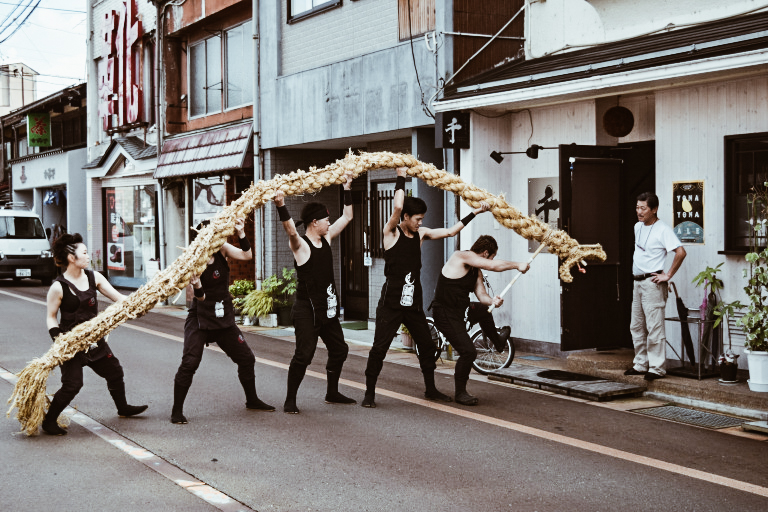
photo credits: myjapantravels.wordpress.com
After that the main event begins. We could say that it is a marriage, but not a common one, but a solemn procession in which the foxes' wedding is celebrated, the Kitsune no Yomeiri.

photo credits: myjapantravels.wordpress.com
The future spouses, a couple bound in real life, are chosen by a pool of candidates at the national level in the town where the wedding ceremony will be held. The long march will lead the bride to the groom as night falls when the Kistunebi begins (a torchlight procession). Those who attend the whole procession will be blessed and can make a wish like a good harvest, or happiness for their family or prosperity in business.

photo credits: tokyopic.com
A romantic curiosity
From 1392, throughout the Muromachi period until the end of the nineteenth century, when Western wedding ceremonies replaced traditional Japanese ceremonies, weddings were held at night and the bride was escorted to her new home by a parade of lights.
Japan History: Shimazu Takahisa
Shimazu Takahisa was born May 28, 1514, son of Shimazu Sagami no kami Tadayoshi (1492-1568), adopted by Shimazu Katsuhisa. He became the lord of Kagoshima after Katsuhisa's escape in 1526. He conquered the aforementioned city in 1536 and extended his authority throughout the province of Satsuma.
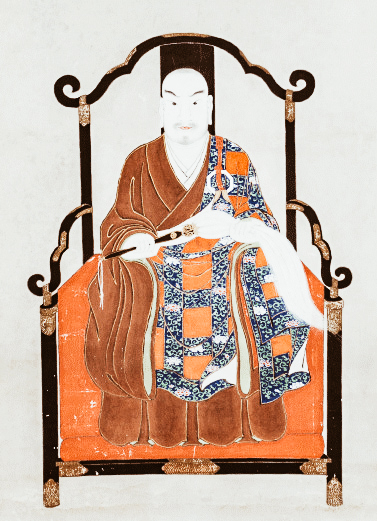
photo credits: wikipedia.org
He was one of the first daimyō to employ firearms in battle during the siege of Kajiki in the province of Ōsumi in 1549. In that same year, he welcomed Francis Xavier to Kagoshima. He granted Jesuit protection to spread Christianity in his domain, later withdrawn under pressure from local Buddhist monks. Takahisa also had diplomatic relations with the Ryūkyu Kingdom.

photo credits: pinterest.com
15th head of the Shimazu clan, he supervised the transfer of the clan's headquarters from Shimizu castle to Uchi castle in 1550 when he sent Ijūin Tadaaki to Shimizu to suppress the rebellions and secure control of the Shimazu over the province. In 1554 his troops won against the Hishikari, Kamō and Ketō clans during the siege of Iwatsurugi. His son Shimazu Yoshihisa later completed the defeat of these clans and secured control of the Shimazu over the rest of the Satsuma province.
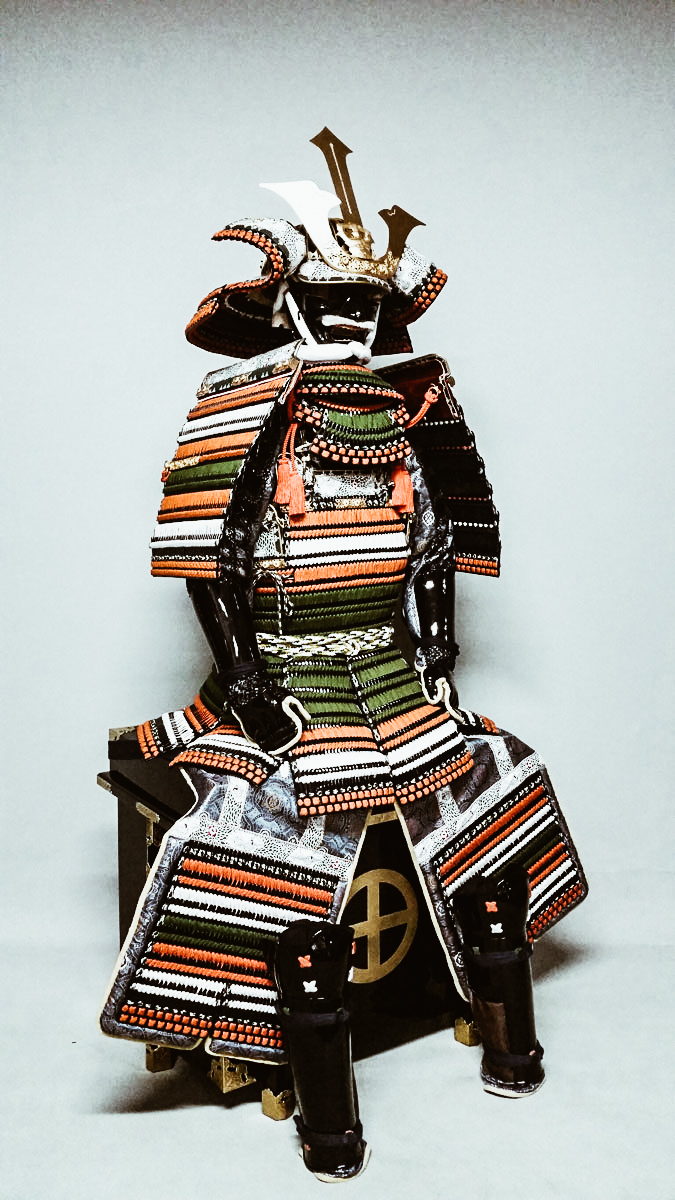
photo credits: global.rakuten.com
He officially retired in favor of Yoshihisa in 1566 and in 1569 the Iriki-in and Tōgō clans were defeated and he secured control over Satsuma. The following year he rejected a naval attack by members of the Kimotsuki, Ijiki and Nejime clans. He died on 15 July 1571.
His idea of promoting relations with foreign people and countries is very important.
His sons were Yoshihisa, Yoshihiro, Iehisa and Toshihisa.

photo credits: wikipedia.org
The Kishiwada Danjiri Matsuri and the rampant euphoria
Every year, generally during a weekend in mid-September, the streets of Kishiwada, a small town near Osaka, are invaded by the fervor and euphoria for the Kishiwada Danjiri Matsuri (岸和田だんじ祭).
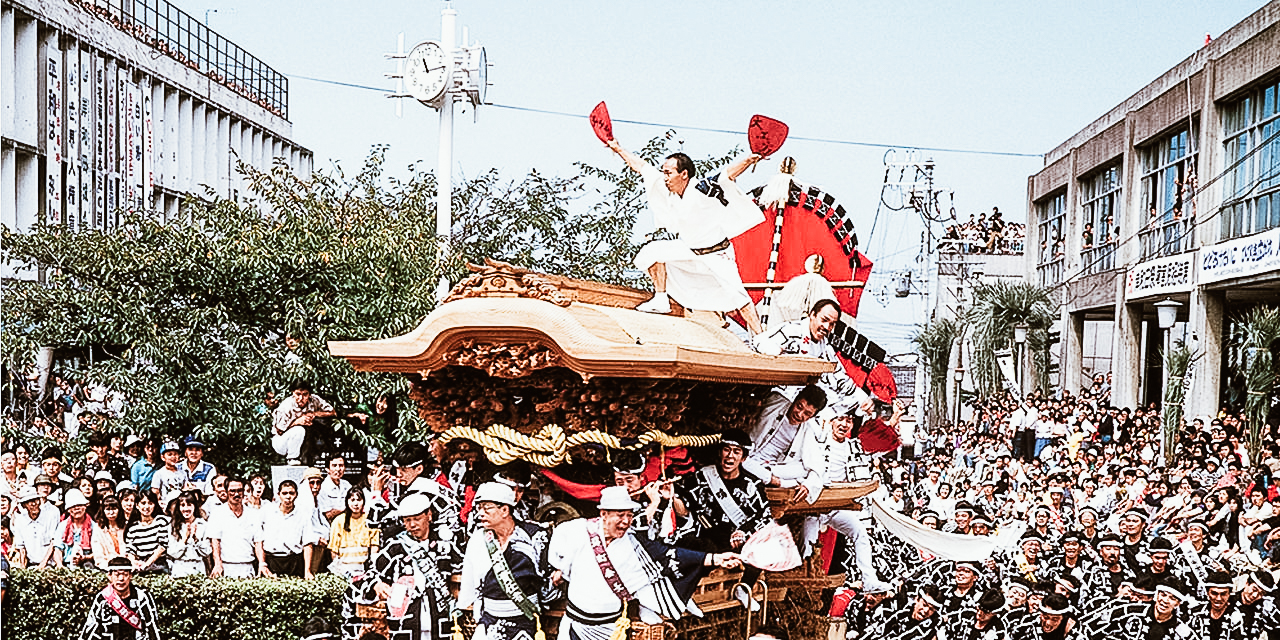
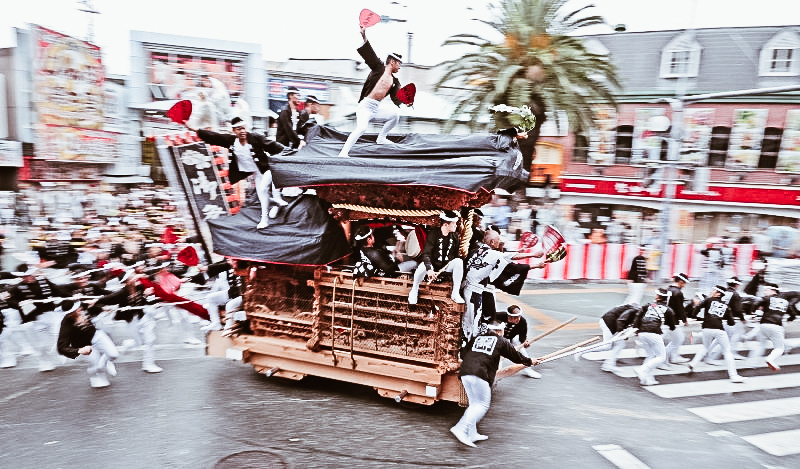
photo credits: airfrance.co.za, mainichi.jp
The celebrations originated in 1703, by the daimyō Okabe Nagayasu (部長泰). He prayed to the Shintoist gods for a bountiful harvest and this is still the meaning of the festival. However, what makes this celebration special is that it is a speed race pulling the danjiri.
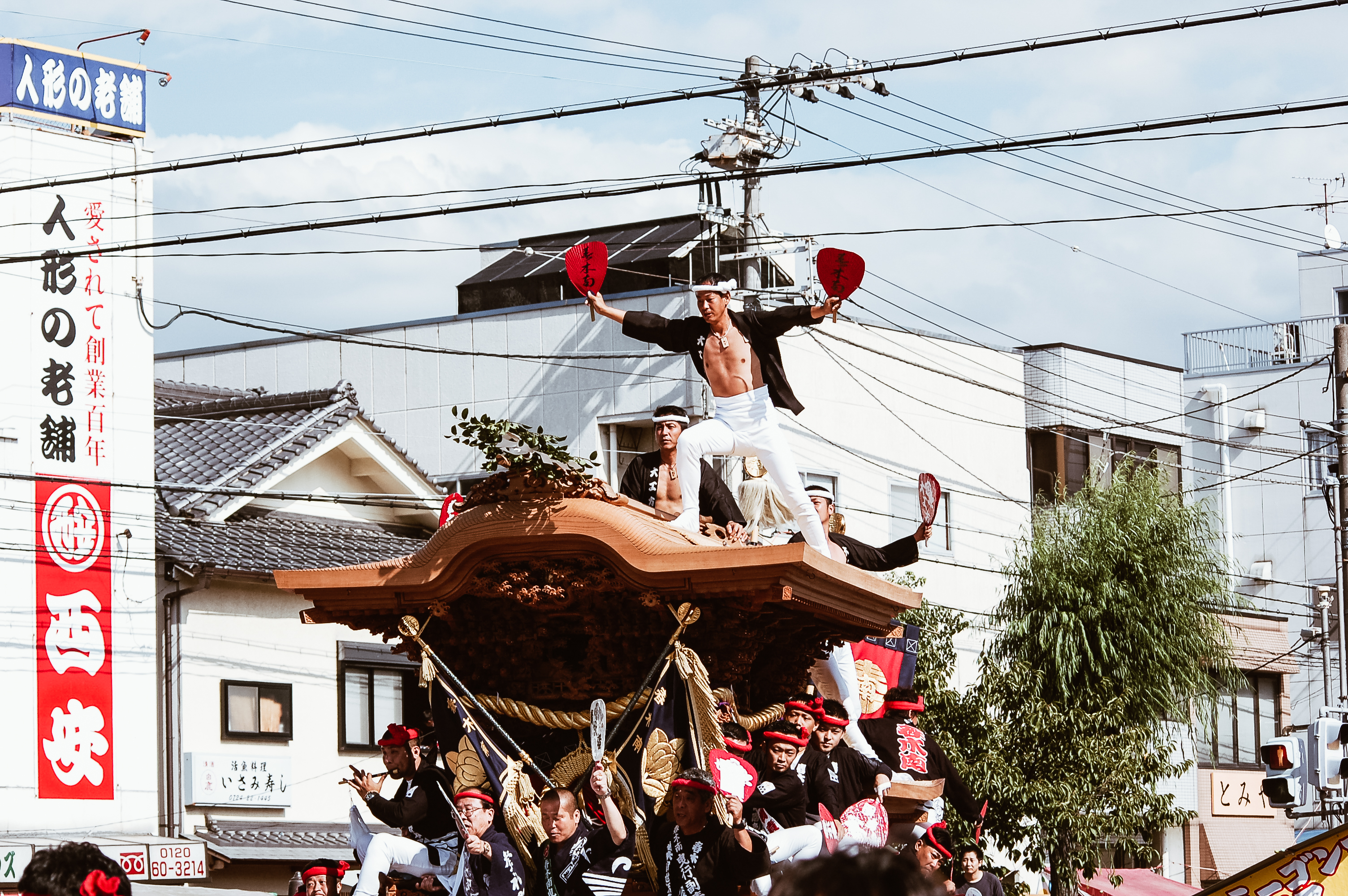

photo credits: Justin Yoshida
Danjiri are traditional wooden structures, carved and finely decorated by skilled carpenters and local sculptors. These wagons have the form of small shrines containing the deities and, during the days of the festival, they are precisely dragged through the streets of the neighborhood. Given their weight (they can exceed 3 quintals), the festival is also considered a moment to demonstrate one's courage. In fact, these structures must be towed with only the help of ropes and at full speed!
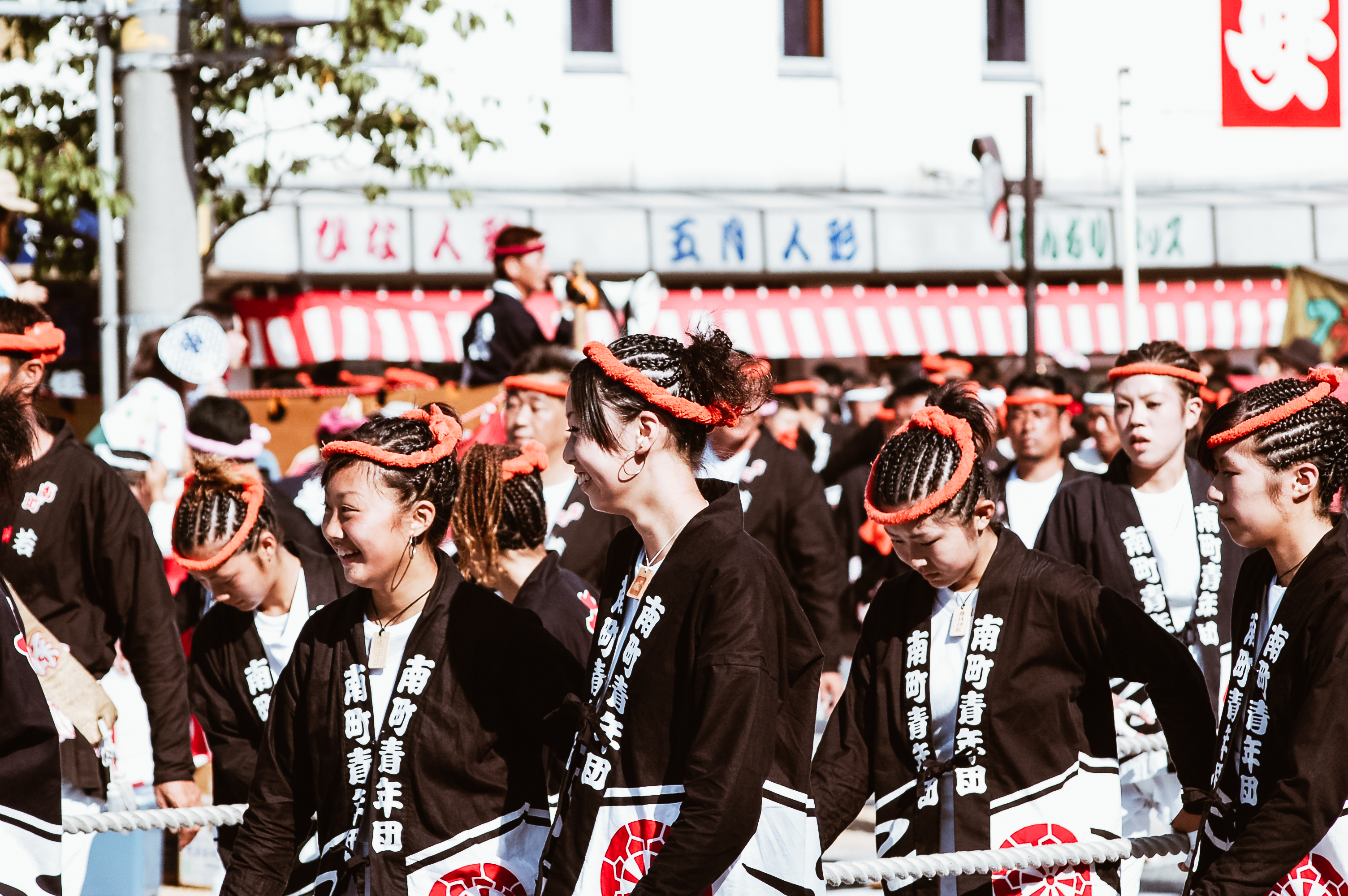
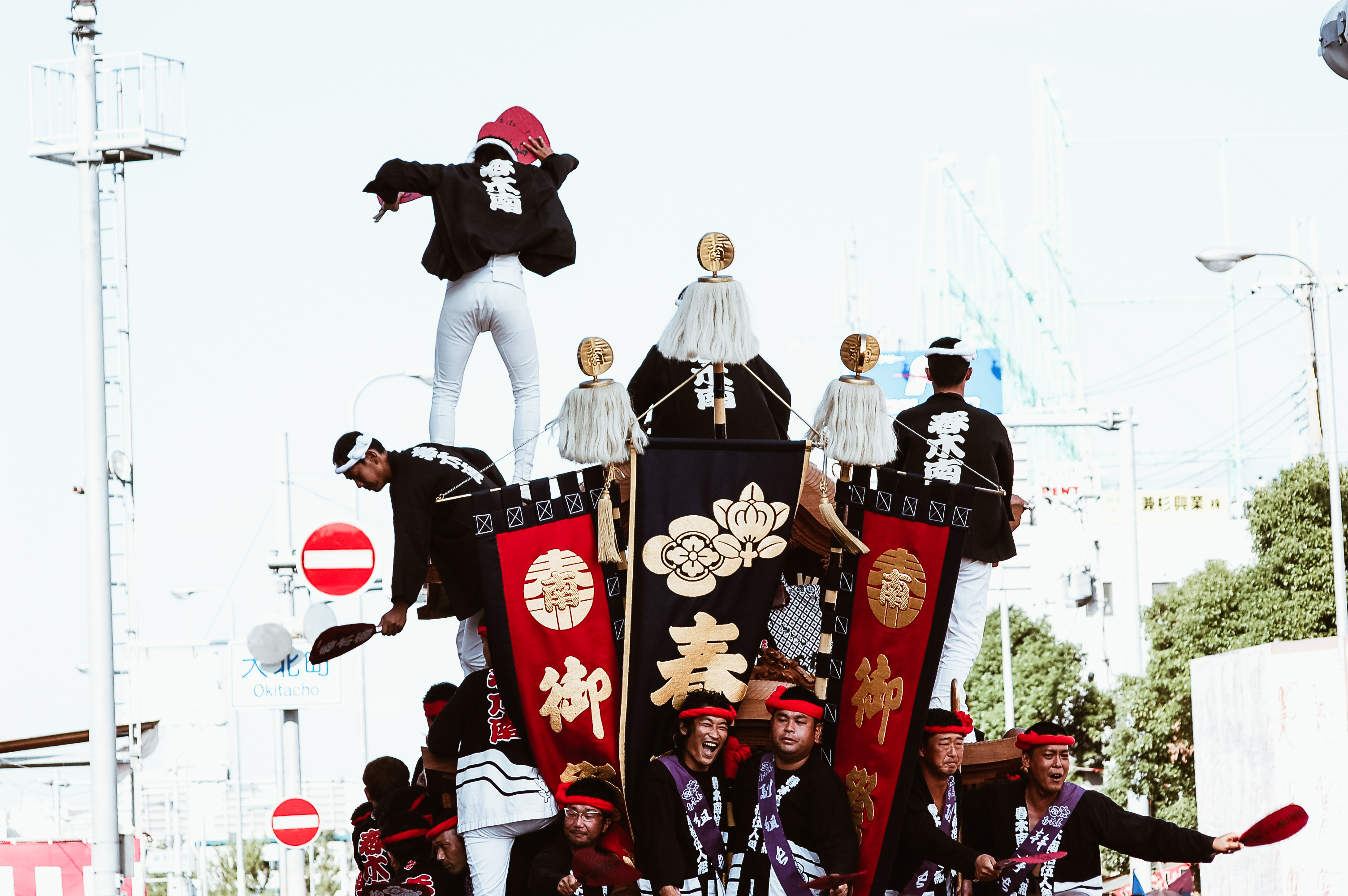
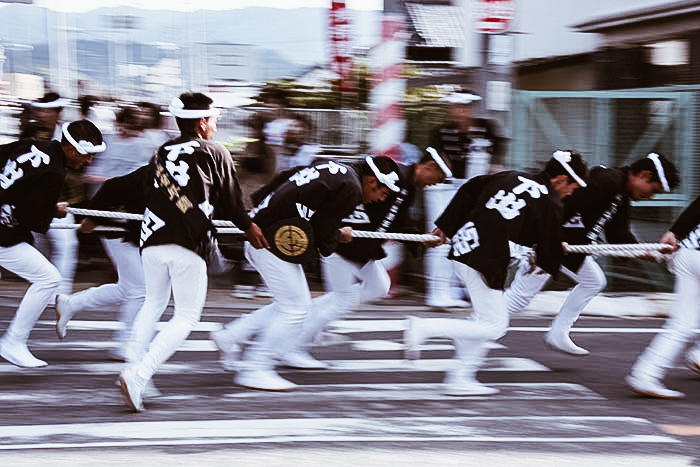

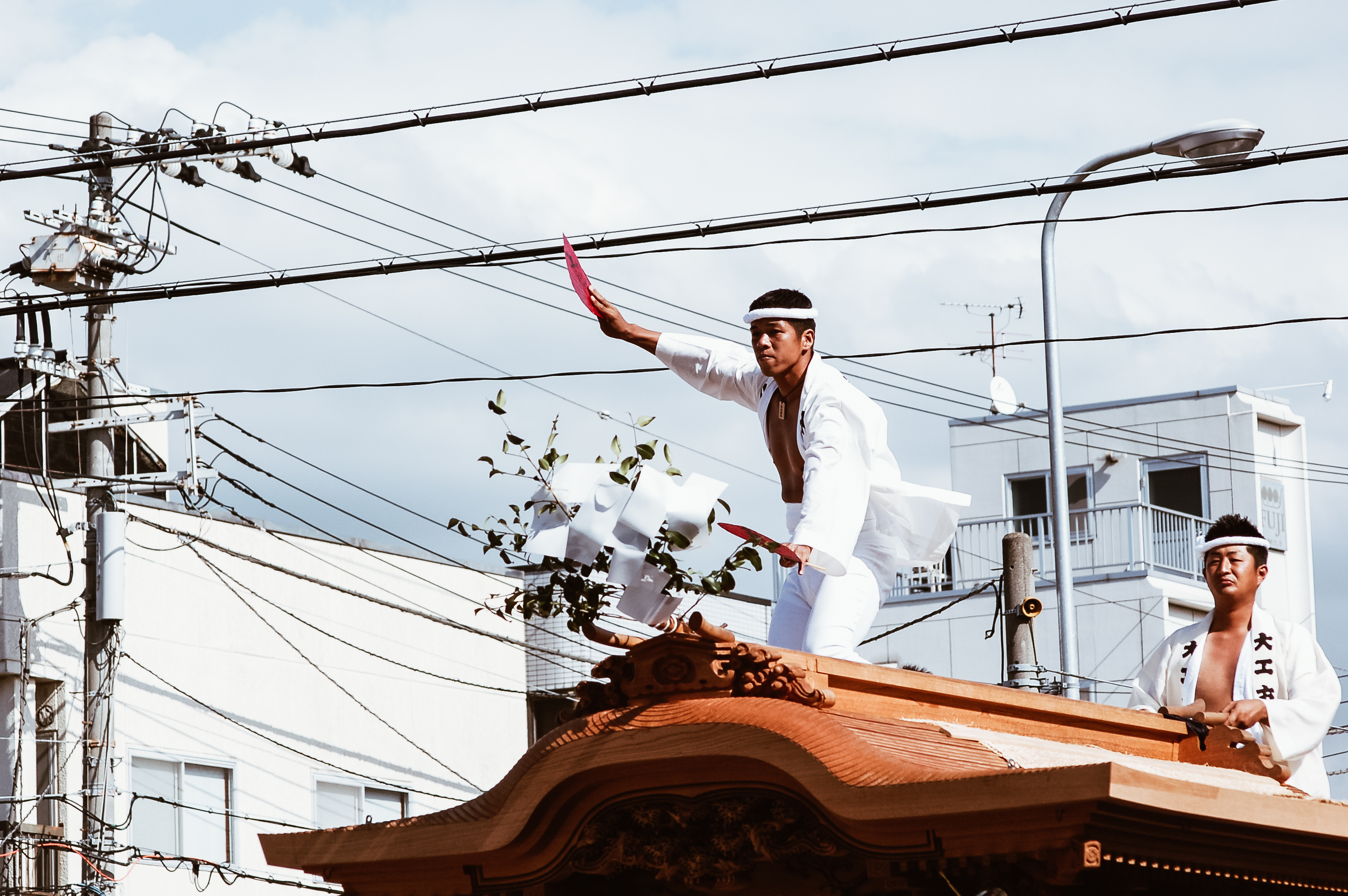
photo credits: Justin Yoshida, Justin Yoshida, japan-magazine.jnto.go.jp, MJY-shogun, Justin Yoshida
Kishiwada Danjiri Matsuri celebrations
During the festival celebrations, there are 35 danjiri involved, each of them being pulled by a team, representing the respective district of the city. At the control of the structure, on its top, there is the daiku-gata (大工方, master craftsman) whose wild dance serves as encouragement for his team and the crowd. Given the stunts in which he engages, the master craftsman risks his life constantly, but not only this! As we can easily imagine, this festival is also dangerous for all other participants due to the danjiri's dizzying speed. The wood splinters left behind and the fact that you have to elbow your way in to follow them is a danger to the crowd. Four hours of breathless running that ends with a big drinking moment around this wagon, to which dozens of paper lanterns are hung.
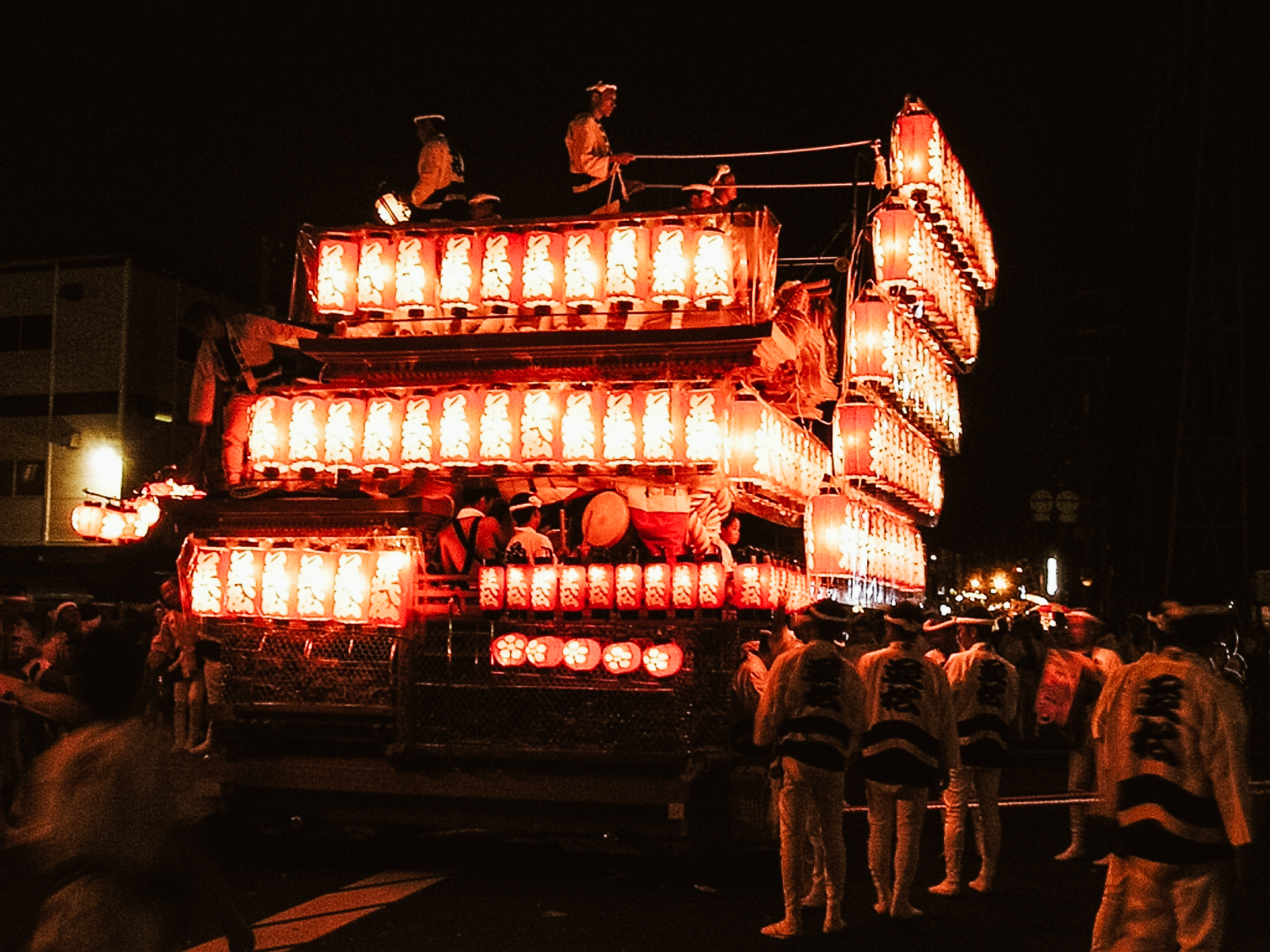
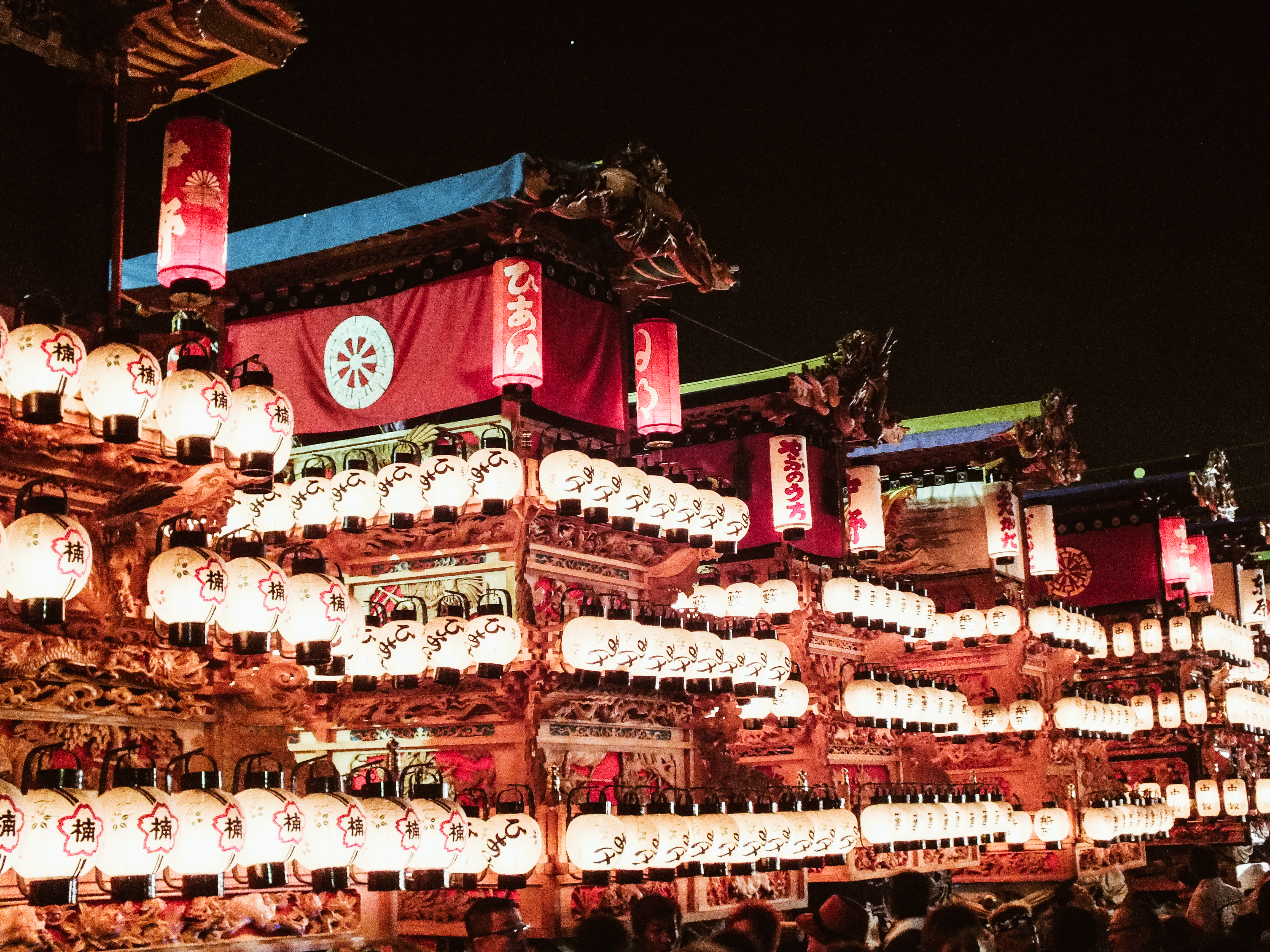
photo credits: rove.me, Gavin Kealy
More than 500,000 visitors come to Kishiwada to experience the thrill of this celebration, what do you think? Do you find this parade electrifying?[:ja]Let's return to talk about Japanese festivals and today we talk about the Kishiwada Danjiri Matsuri.
Japan History: Kusunoki Masashige
Kusunoki Masashige, (1294 - 4 July 1336) was born in Minato-gawa, province of Settsu, and was a 14th century samurai who fought for the Emperor Go-Daigo in the Genkō war.
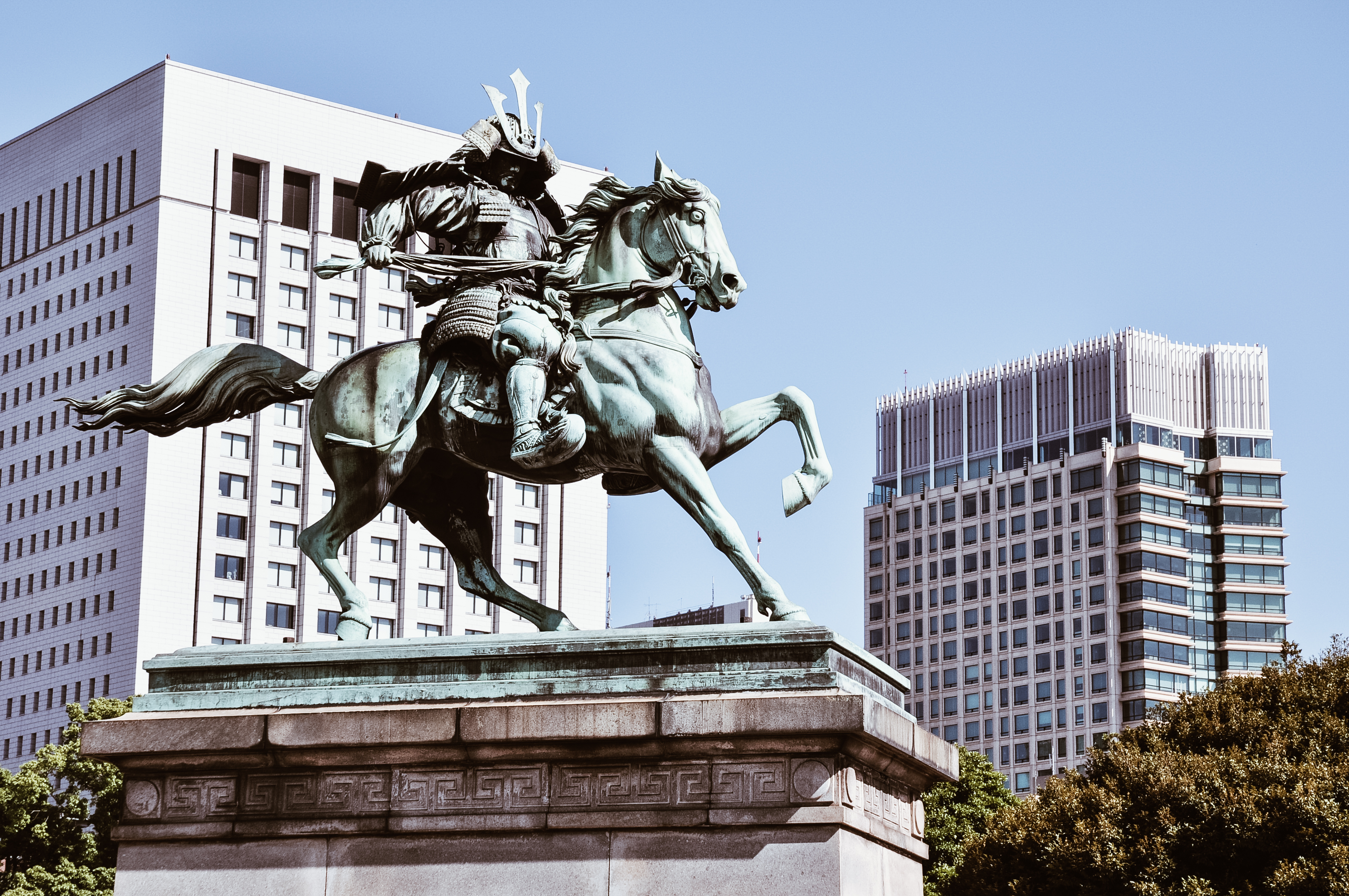
photo credit: ninja.fandom.com
Much of his early education took place in the Kanshin-ji temple in Kawachinagano, in the south of Osaka, where he later organized major restoration work.
Legend has it that the emperor Go-Daigo had a dream in which he was taking refuge under a camphor tree (the "kusunoki"). This dream brought him to the surname of the warrior who would support him. Indeed, in 1331 Kusunoki joined the emperor Go-Daigo in a revolt to wrest government power from the shogunate, the military dictatorship that had dominated Japan since 1192. Although numerically stronger shogunate troops captured the emperor, Kusunoki fled continuing to use guerrilla tactics.
The capture of Kusunoki near Nara in 1332 proved to be a serious threat to the government. The shogun then concentrated all his forces against Kusunoki. In one of the most famous battles in Japanese history, Kusunoki successfully defended the fortress of Chihaya against the upper shogunal forces.
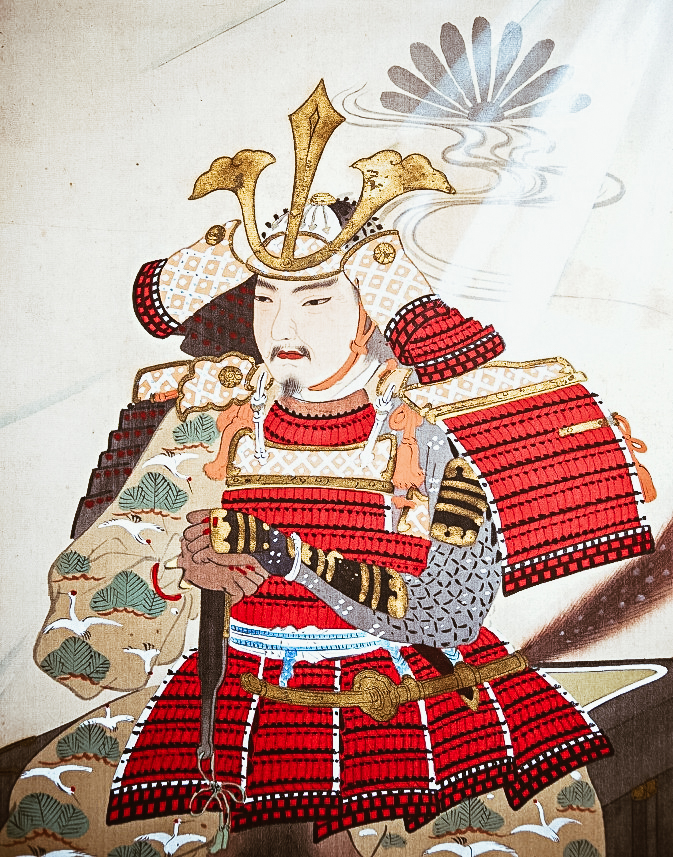
photo credit: davtov2000.blogspot.com
From 1333 to 1335
In 1333, Go-Daigo rewarded Masashige with the governorate of the province of Settsu and the province of Kawachi and promoted him to the fifth degree. Subsequently, he received the appointment on the Records Office and Settlement Board. However, one of the loyalist generals, Ashikaga Takauji, betrayed Go-Daigo and led an army against Kusunoki. Takauji took possession of Kyoto, but only temporarily before Nitta Yoshisada and Masashige forced Takauji to flee. In 1336 Takauji was again a threat to Kyoto.
During the short period following the imperial rule, Kusunoki was governor of the central Japanese provinces of Settsu. The real power in the countryside, however, continued to be held by the great hereditary lords, Ashikaga Takauji and Nitta Yoshisada. The latter openly challenged themselves to obtain the loyalty of minor feudal leaders.
Kusunoki suggested to the Emperor to take refuge on the sacred Mount Hiei and allow Takauji to take Kyoto. This is to allow him to descend from the mountain and, with the help of the monks of Mount Hiei, trap Takauji.
Go-Daigo was not willing to leave the capital and insisted that Kusunoki meet Takauji's forces on the field. Kusunoki, in what would later be seen as the last act of samurai loyalty, accepted obediently. The battle, which took place in Minatogawa, in present-day Chūō-ku, Kobe, was a tactical disaster. There are two reports of the proposal made by Kusunoki Masashige to the emperor Go-Daigo, the Taiheiki and the Baisho Ron, entbe ingorati. One was that they would group together and attack from two sides, the other was that they would take General Takauji back on their side.
Kusunoki's army was only 50 of the 700 knights. According to legend, the last words of his brother Masasue were Shichisei Hōkoku! ("I wish I had seven lives to give to my emperor!") Obviously Kusunoki Masashige agreed.
At his death, his head was sent to Kanshin-ji and buried in a tomb known as Kubi-zuka.
Eboshigata Castle and Ishibotoke Castle were both built along the route of the Koya Kaido, a famous pilgrimage route that stretches between Kyoto and Koyasan. Designed not only to protect the path from bandits, these were also an important source of income as travelers were forced to pay a toll.
From 1335 to the Meiji restoration
In 1335 Go-Daigo sided with Nitta Yoshisada against Ashikaga Takauji. As head of the imperial forces, Kusunoki defeated Takauji's troops in January 1336 and forced him to flee the capital. A few months later, however, Takauji returned to the head of a large army. Kusunoki suggested temporarily withdrawing so he could fight Takauji's forces at a point where the terrain was more favorable. The emperor insisted that Kusunoki meet enemy forces before occupying the capital. In the final battle on the Minato River, near the modern Kobe, Kusunoki fought bravely for many hours. His troops were finally overwhelmed and committed suicide rather than face capture.
His son, Kusunoki Masatsura, served as the emperor's successor, 12-year-old Go-Murakami, in a relationship of mutual trust that reflected the figure of his father Kusunoki and kept the flame of loyal resistance alive.
After the imperial restoration in 1868, a splendid sanctuary was erected on the site of Kusunoki's death. His loyalty to the emperor and his being one of the greatest military strategists in Japanese history, made him a legendary figure. He also received the highest decoration from the Japanese Meiji government in 1880.

photo credit: wikipedia.org
Legend
After the introduction of Neoconfucianism as a state philosophy by the Tokugawa shogunate, Kusunoki Masashige was declared with the emperor Go-Daigo forerunner of the synocentric absolutists. During the Edo period, scholars and samurai who were influenced by neoconfucian theories created the legend of Kusunoki. They consecrated him patriotic hero, with the name of Nankō or Dai-Nankō, incarnation of loyalty, courage and devotion to the Emperor. Kusunoki later became a sort of patron saint of the WWII suicide bombers. His spiritual heirs were those who sacrificed their lives for the emperor.
Japan Tradition: Akita Kantō
The Akita Kantō (秋田竿燈まつり) is the Akita city festival. It is celebrated from 3 to 7 August with the aim of praying for a good harvest. This festival is very special, and to participate there is a need for special skills.
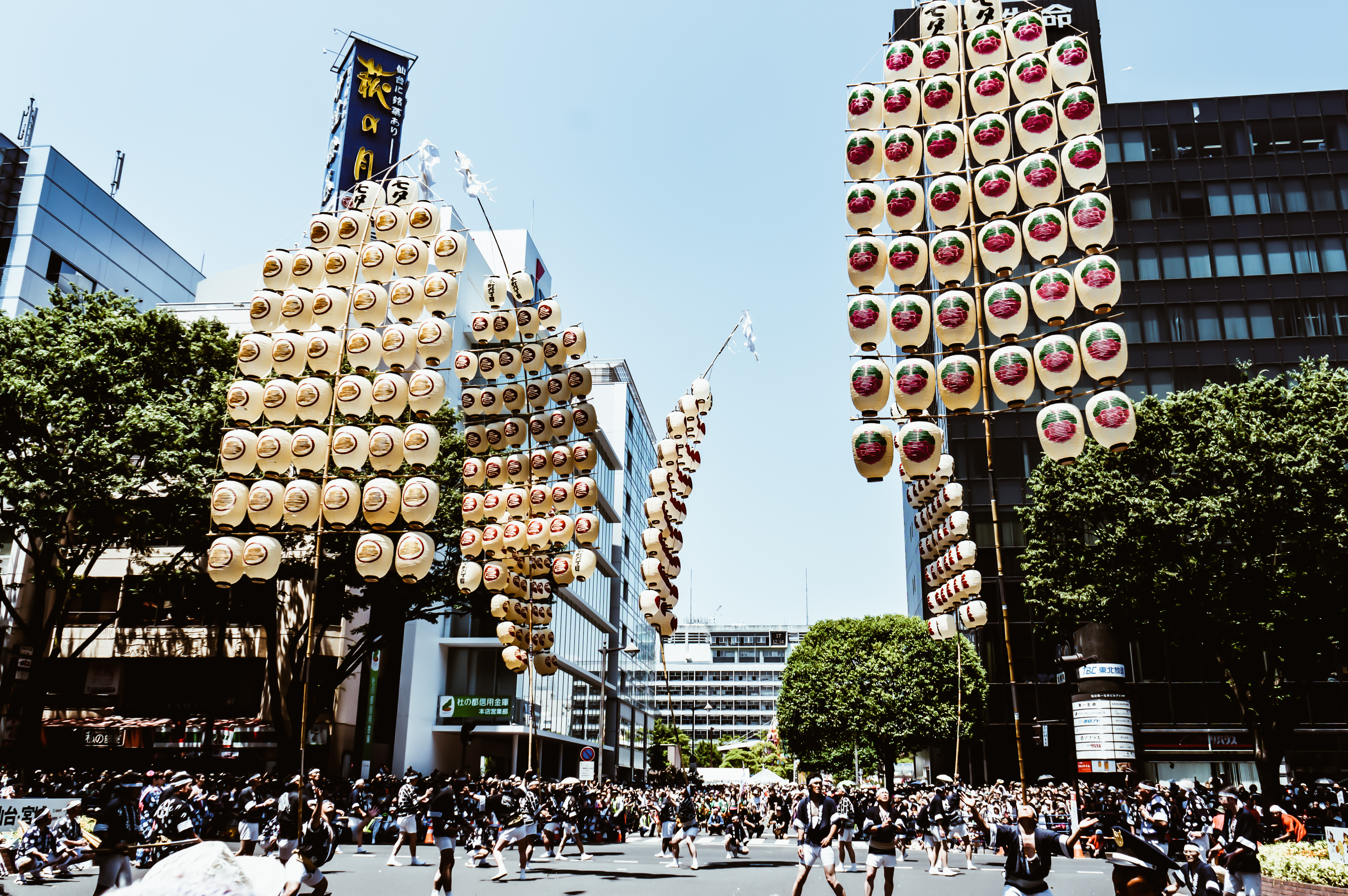
photo credits: Zamboni.
The peculiarity of the Akita Kantō
If you have never had the chance to attend this particular matsuri, surely today you will be surprised. In fact, the festivities consist of taking bamboo poles around the city by night. And so far it could even be simple, except that these poles have a length that varies from five to twelve meters. Furthermore, on top of these, there are twenty-four or twenty-six lanterns with gohei (wooden sticks) attached. The total weight of these poles can reach 50 kilos. They are transported through the city streets on the palms, foreheads, shoulders or backs of the participants.
The Akita Kantō is one of the main festivals in the Tōhoku region together with the Tanabata, the Aomori Nebuta Matsuri and the Hanagasa Matsuri. In fact, in 1980 it was defined as an important and intact property of folk culture.
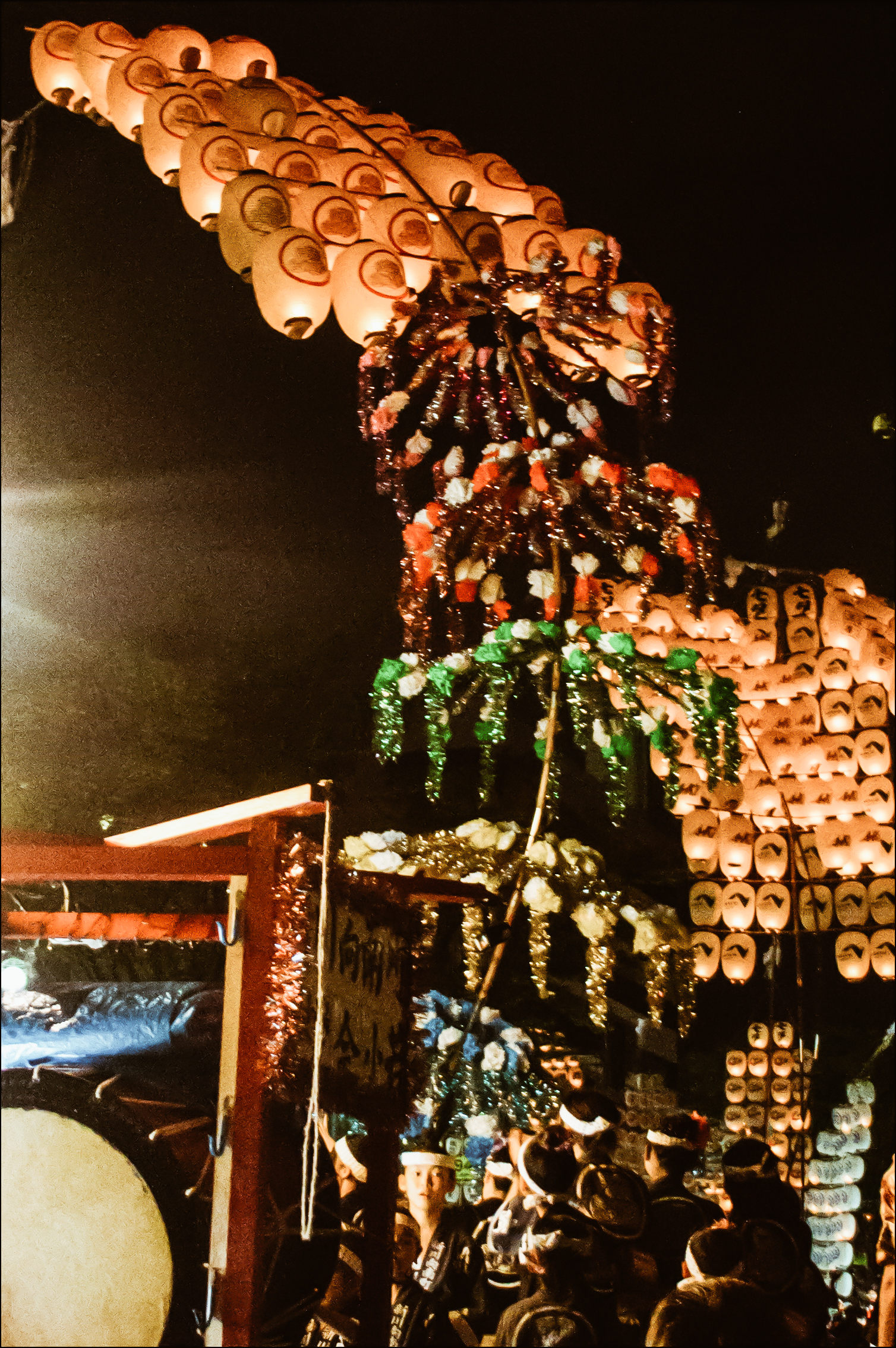

photo credits: Laura Tomàs Avellana, hitoyam
The origins
The festival originates from Neburi Nagashi, a celebration that was intended to free from illness and negativity during the summer. Already present during the Horeki period, in the middle of the Edo era, evidence can be found in various historical documents. One of these is "Yuki no huru michi" (written by Soan Tsumura in 1789). This is indeed the oldest documentation describing Neburi Nagashi, which says that the festival was held on 6 July according to the lunar calendar and it's defined as the original Akita tradition.
During Neburi Nagashi, people decorated bamboo trees and plants with pieces of paper where they wrote their wishes. Later, the participants walked around the city with these plants along with candles and lanterns. Later, Neburi Nagashi took the name of Kanto.



photo credits: foxeight
The history of the Akita Kantō
The current name of the event was used for the first time by Tetsusaku Okubo in 1881. In this period, in fact, the emperor Meiji visited Akita. Here Okubo suggested entertaining the emperor with the Kanto performance.
Due to the change of the lunar-to-solar calendar in 1872 and given the smaller number of Kanto participating in the festival, the realization of the latter began to be uncertain.
However, in 1908 the emperor Taisho visited Akita and fell in love with the Kanto performance. The following year, a soft drink company printed its products' names on the Kanto lanterns. These two events led to the restoration of the Kanto festival and its change of dates, to avoid the rainy season.
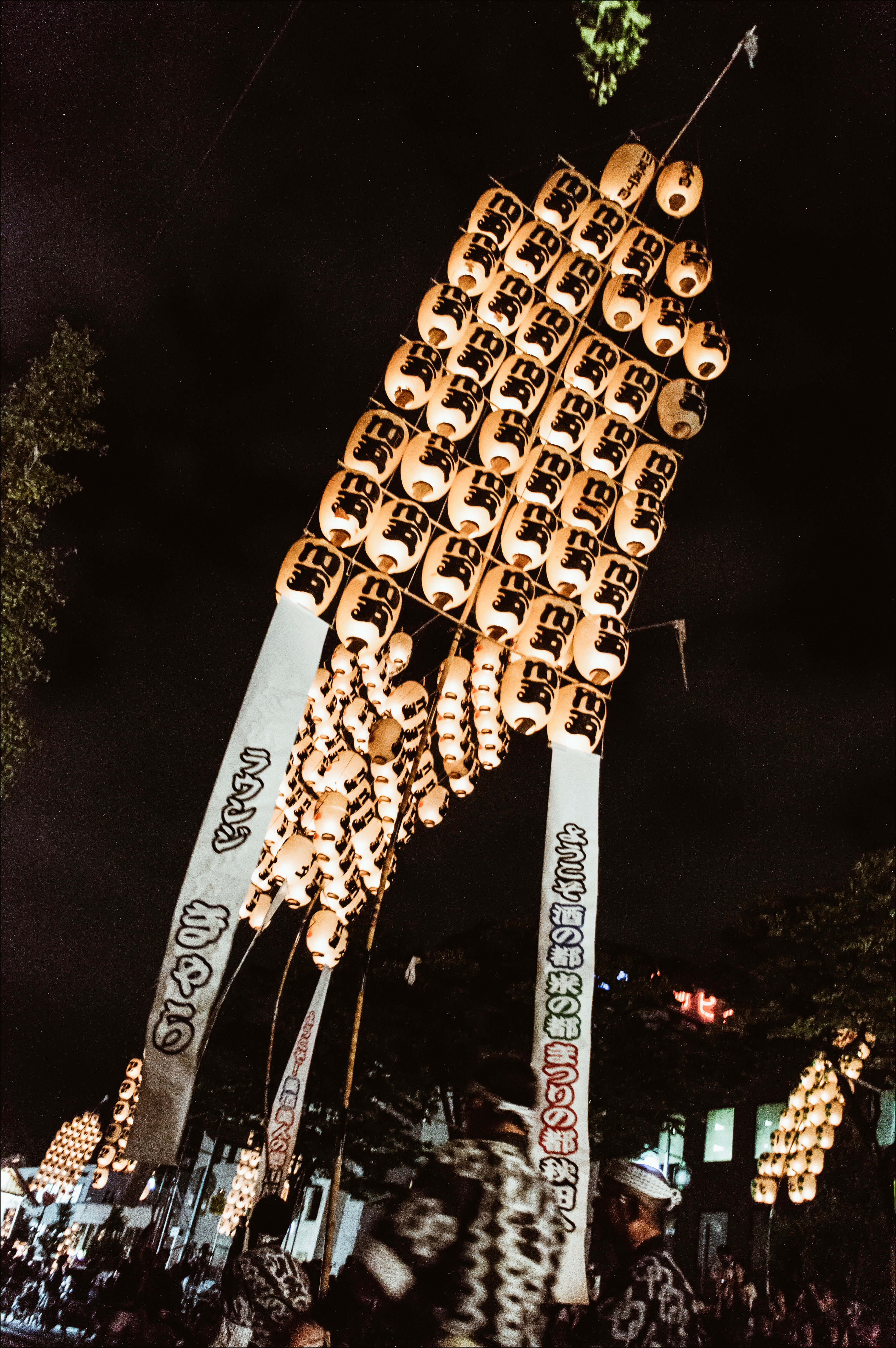
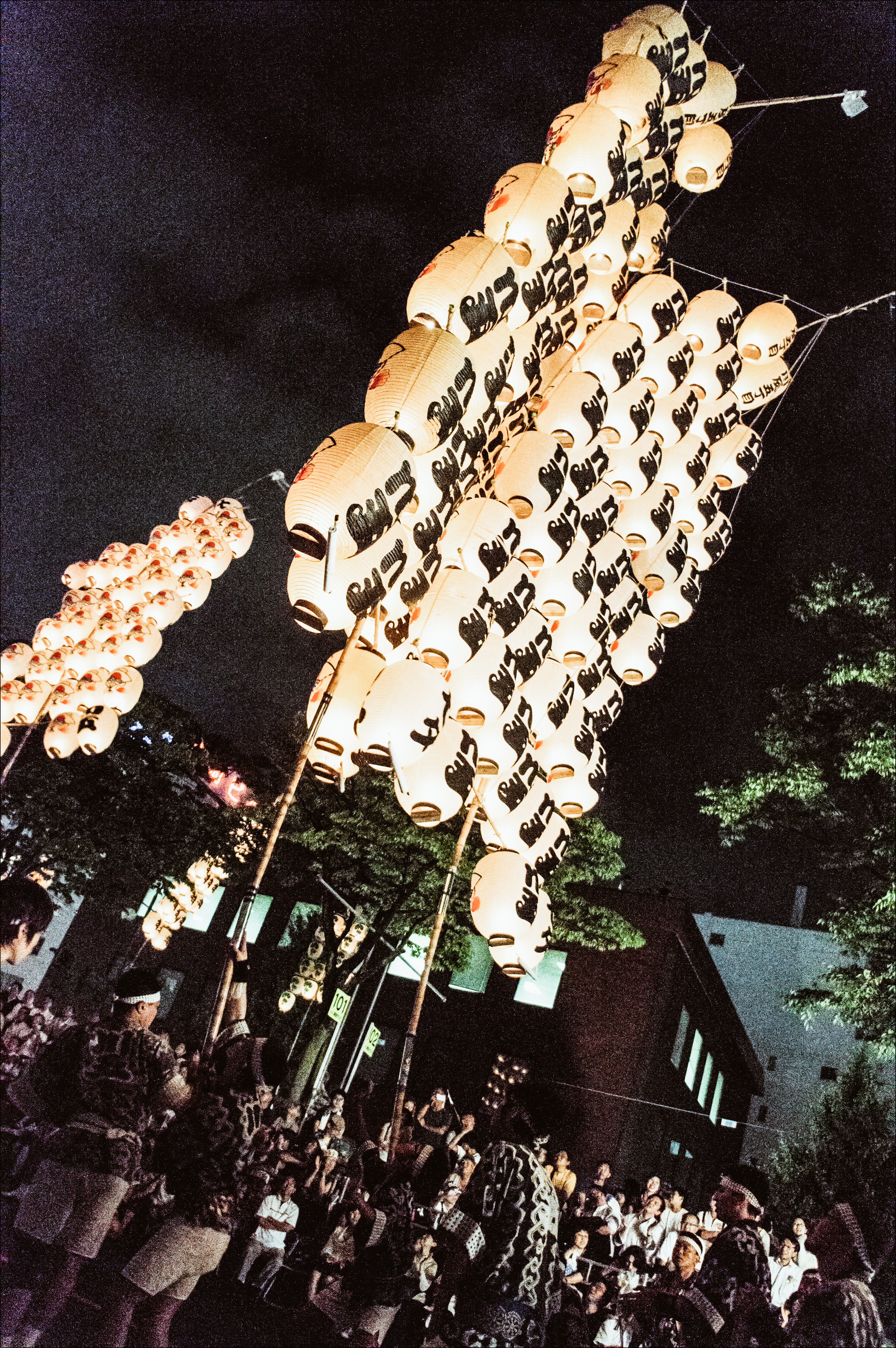
photo credits: Laura Tomàs Avellana
As a result, the number of visitors increased and the Kanto Society was established in 1931 was in charge of managing the festival.
Afterwards, the festival was canceled during the Second World War, and then after the end of the conflict, the Executive Committee of the Kanto Festival was created.
In 1976, after a successful performance in San Diego, USA, Kanto became popular in various countries.
Cos’è il Kantō
Literally, Kantō means "a pole with lanterns" and is made from bamboo poles and rice paper lanterns hung on horizontal bars.
The main bamboo pole is called "Oyatake" and they are of rather thick features and all produced in Japan. There are even very strict rules on the thickness and the spaces of junction from the root for these poles.
Therefore, people who choose the pole must be very demanding on the type of bamboo used to produce Kantō.

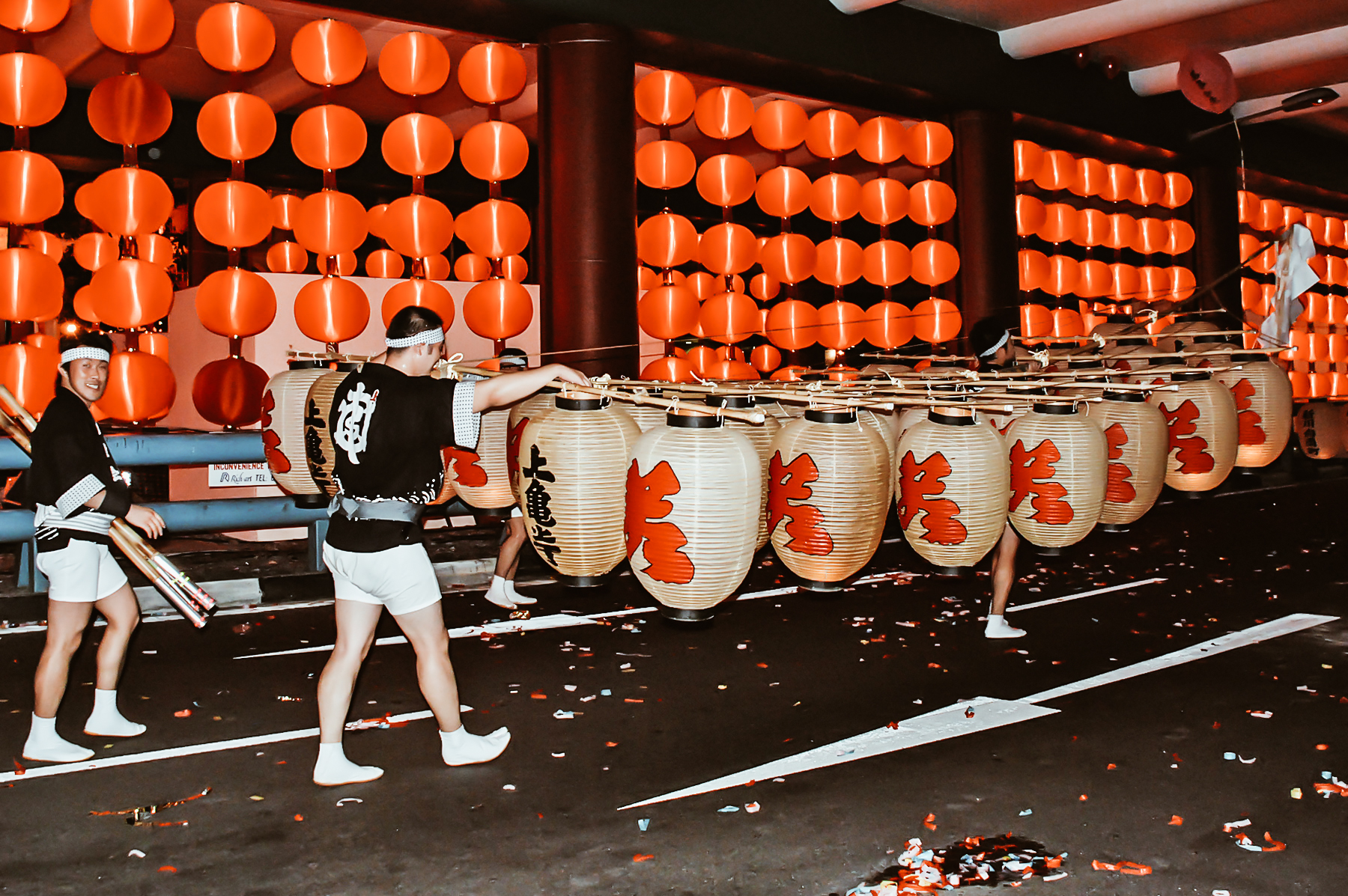
photo credits: Laura Tomàs Avellana, Choo Yut Shing
The horizontal branches are called "Yokotake" and it is here that lanterns are hung. The pieces of bamboo used to make the Oyatake even longer are called "Tsugidake".
The Kantō are divided into four categories with regulated length: Oowaka, Chuwaka, Kowaka and Youkawa.
Kantō techniques
There are various techniques for using Kantō from the name "Myogi" and divided into 5 categories.
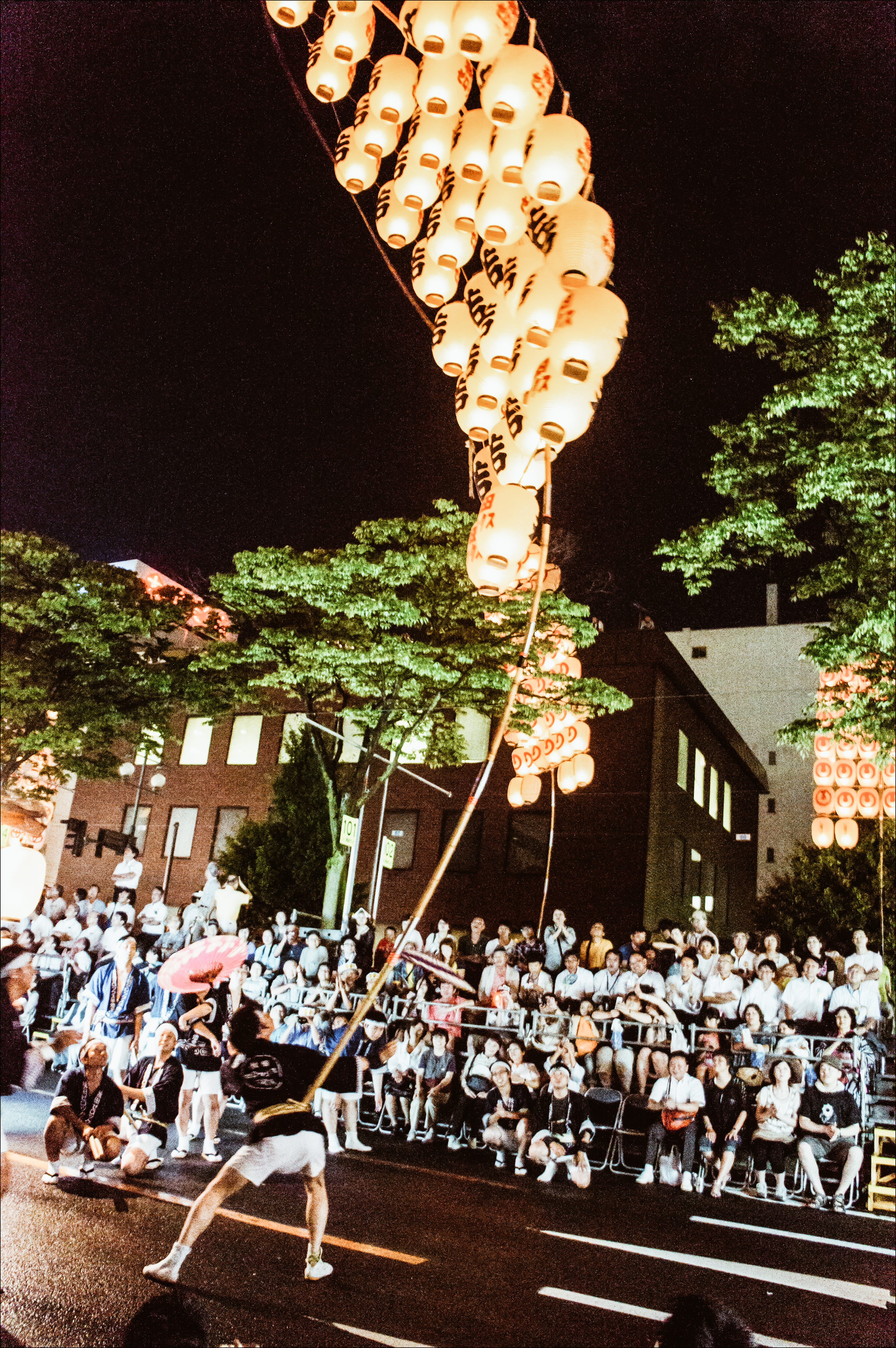

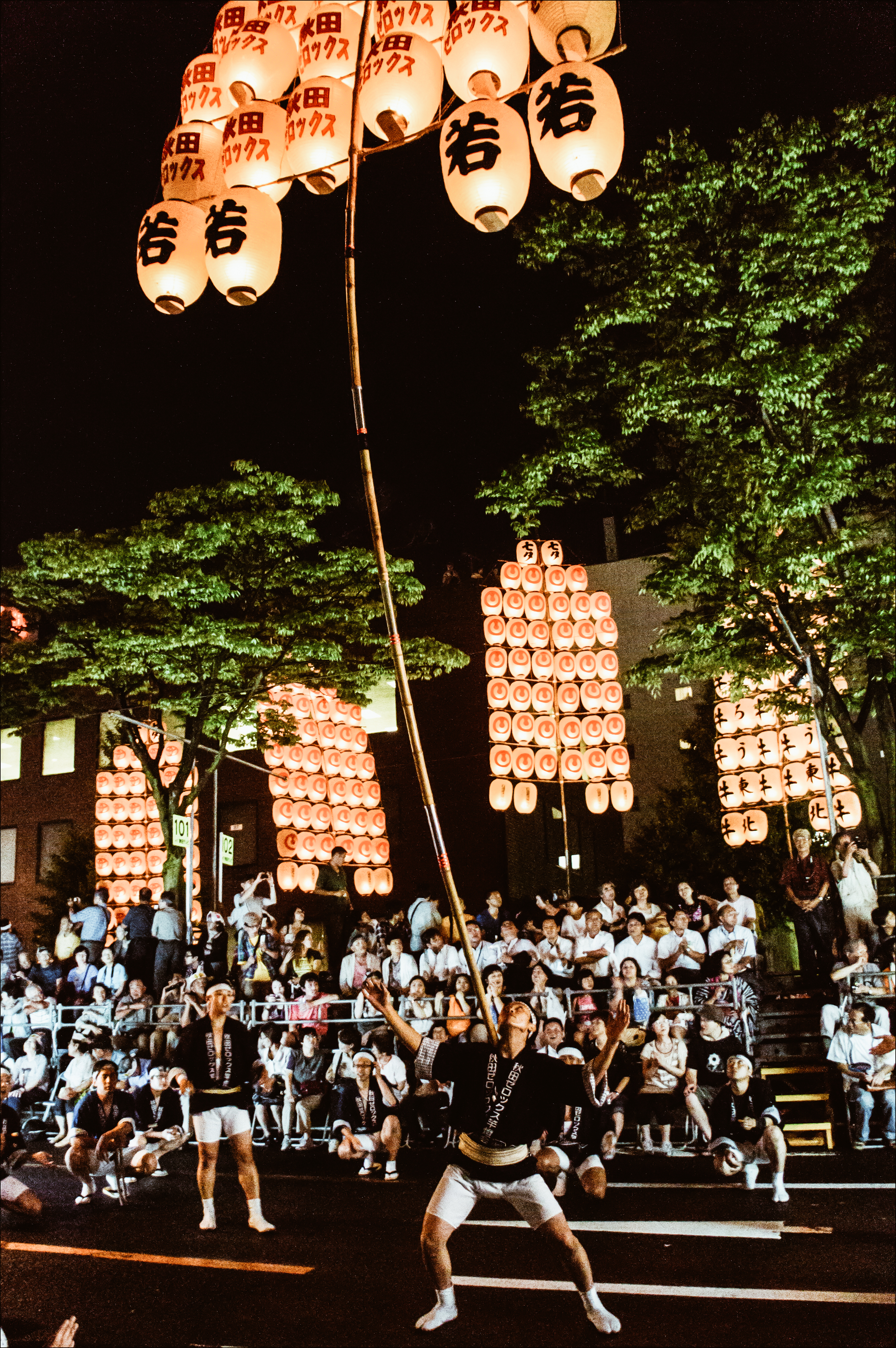
photo credits: Laura Tomàs Avellana
Nagashi
The artists hold the Kantō in the palm of their hands and balance it with their fingers. In this way, other artists can add Tsugitake
Hirate (hand)
The artists hold the Kantō still higher in the palm of his hand
Koshi (hips)
Kantō is held by the fingers. Later moved to the palm of the hand and then to the side. The artist bends sideways and balances with his own legs.
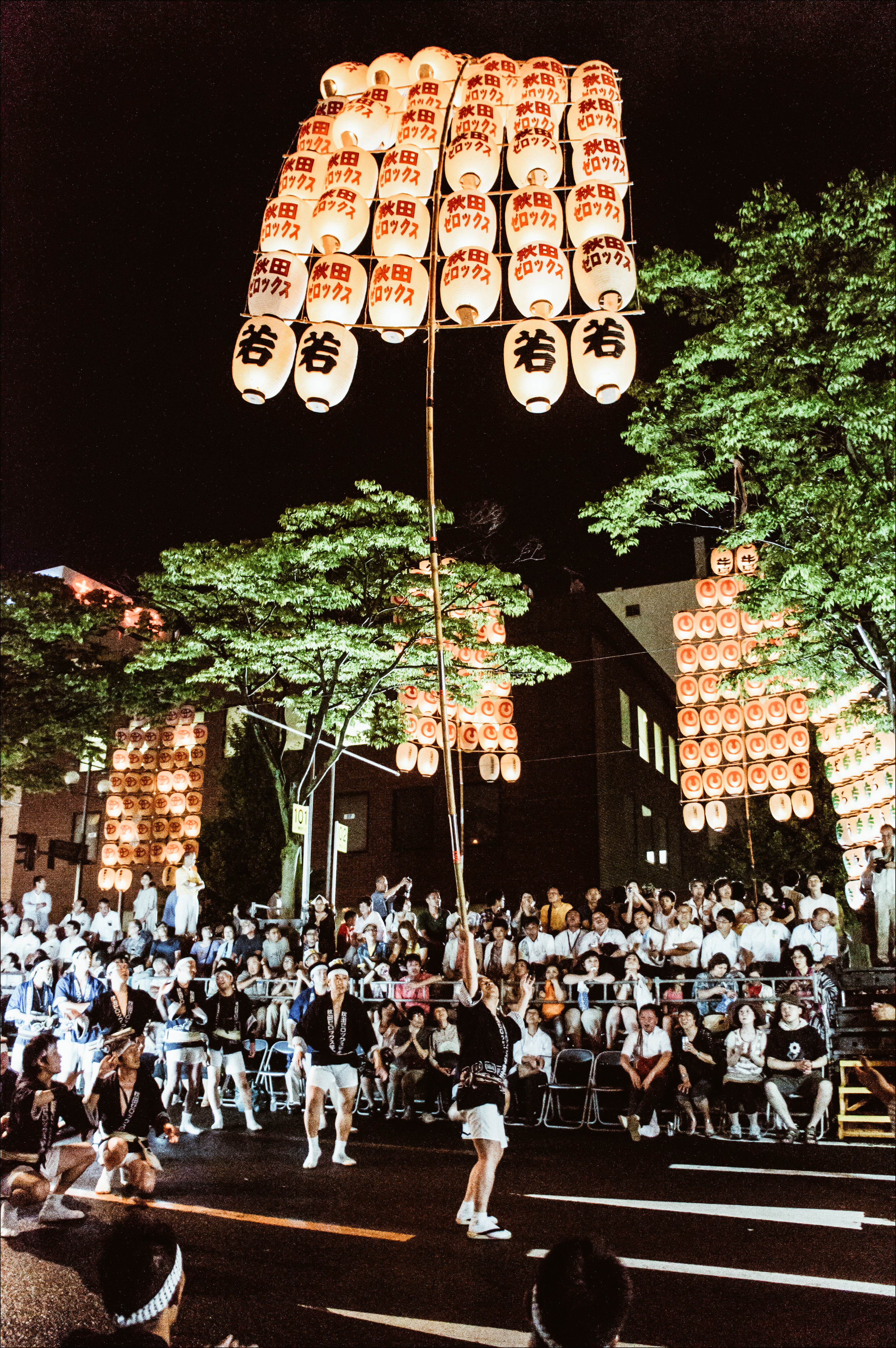
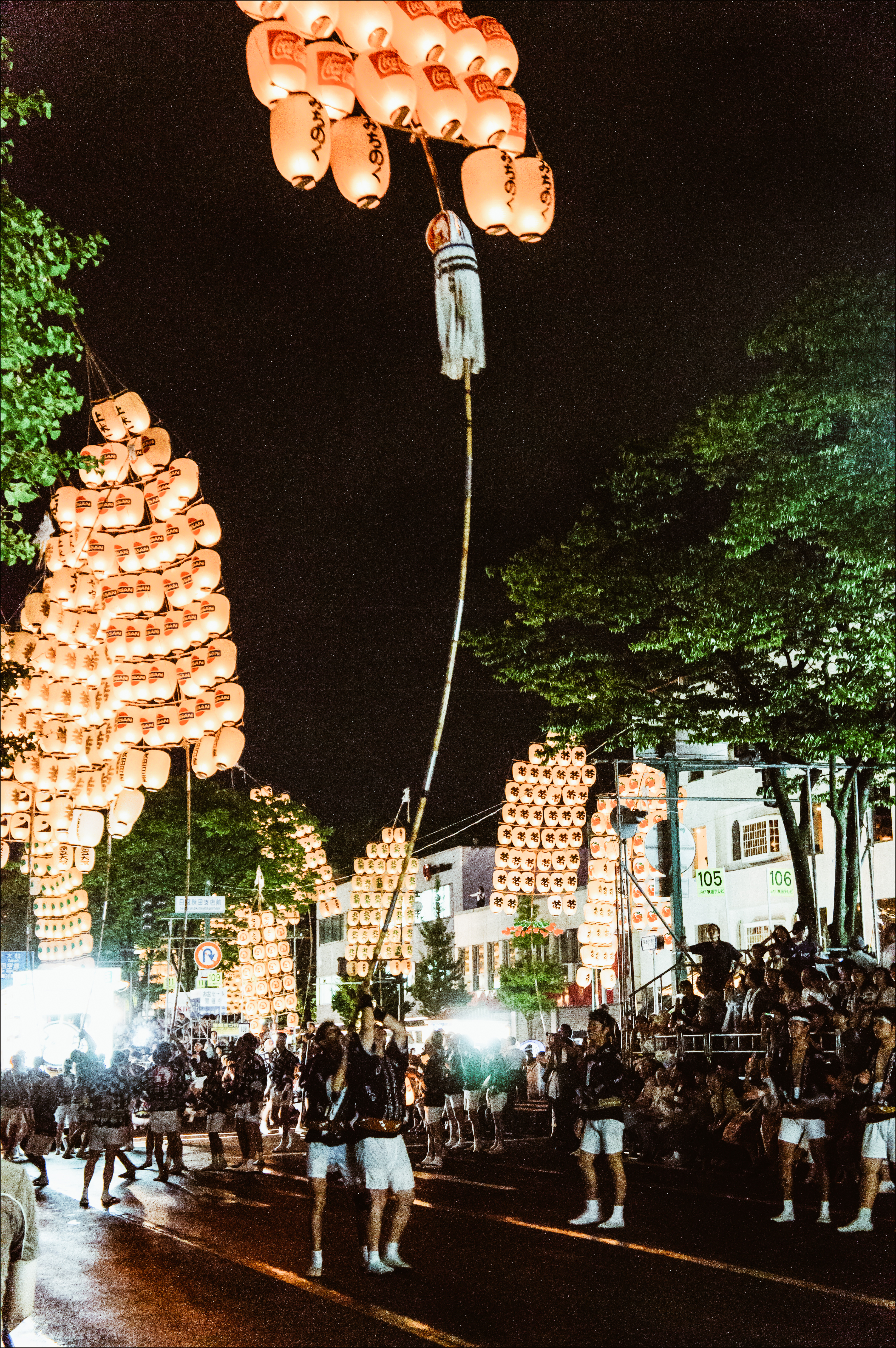

photo credits: Laura Tomàs Avellana
Kata (shoulder)
The artists hold the Kantō in the palm of their dominant hand and form a starting line from the leg to the Kantō, raising it even higher.
Hitai (forehead)
The artist holds the Kantō with his fingers and then moves it to the palm, then on the forehead.
During the day there are also competitions to test these skills, the Myogikai. The aim is not only to show their skills but also to study those of the other participants to learn new techniques.
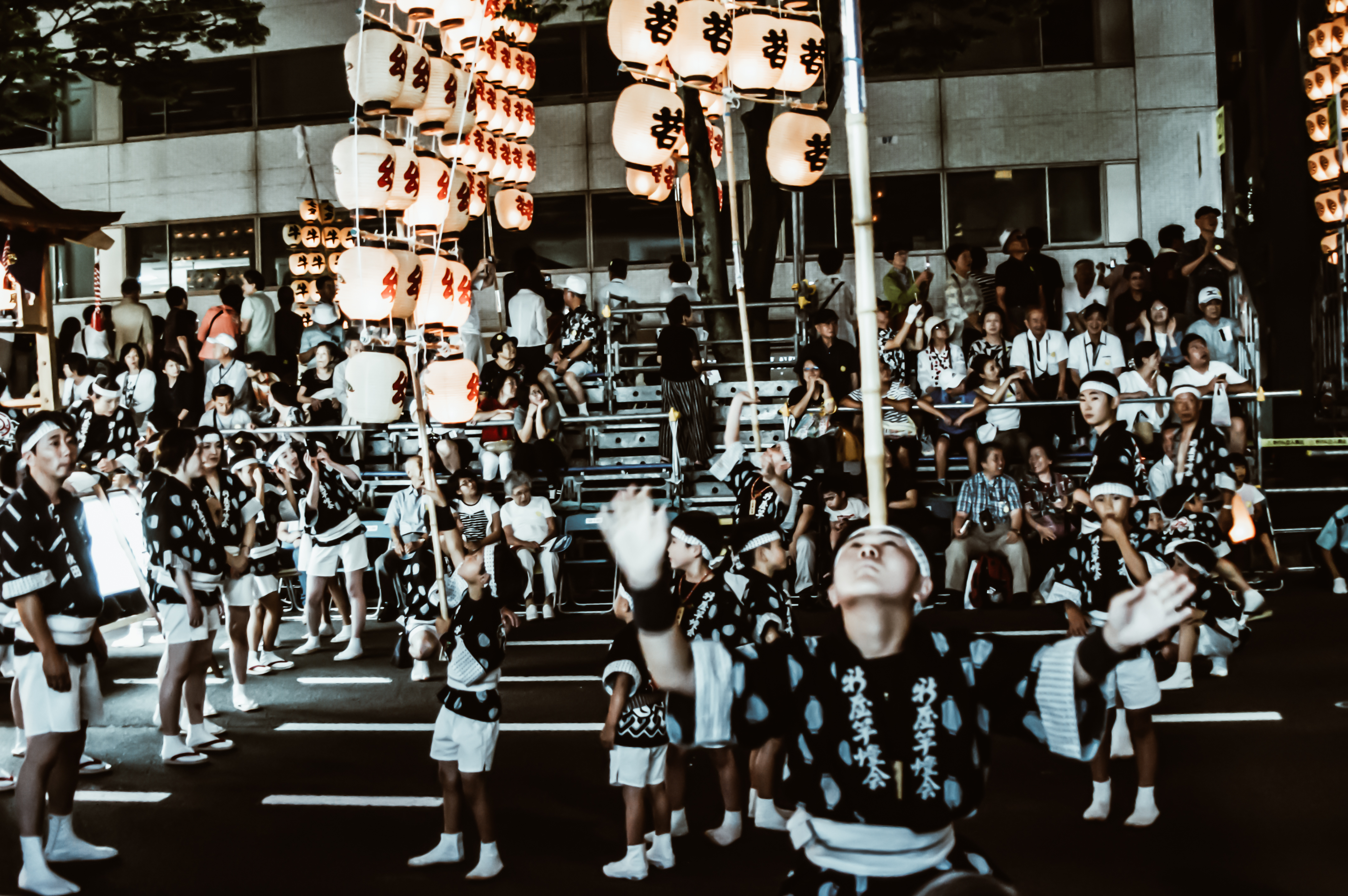

photo credits: foxeight
The Akita Kantō today
The date of the festival has been changed three times. It is currently held from 3 to 6 August each year.
The evening performance of the Akita Kantō is the main one and is held at the Kanto Oodori, one of the main streets of Akita. Here the purpose of the performers is not to compete with each other, but to entertain visitors by showing their skills and illuminating Kanto. More than 230 are raised at the same time to the sound of taiko music and flutes.


photo credits: foxeight
A unique experience of its kind that is worth living in full, as soon as you have the chance.
Japan History: Takeda Shingen
Takeda Shingen (Takeda Harunobu December 1, 1521 - May 13, 1573), firstborn of warlord Takeda Nobutora, was born in the powerful Takeda clan. He was Shugo Daimyo (military governors) of the then province of Kai, present-day Yamanashi prefecture.
Takeda Shingen played a very important role in the battle of Un no Kuchi in 1536, he was only 15 years old. When his father designated his second son as heir, Shingen conducted a coup without bloodshed. This forced his father to retire as head of the clan. Later, Shingen began to expand his family's domains northward into the province of Shinano (present-day Nagano prefecture) and into lands adjacent to Kai.
As the undisputed leader of the Takeda clan, he began his expansionist policy starting with the Battle of Sezawa. He then continued with the sieges of Uehara, Kuwabara and Fukuyo, the battles of Ankokuji, Odaihara, Shiojiritoge, and the Kawanakajima battles series against Uesugi Kenshin.
Shingen decided to have all the warriors in the first lines of his armies wear red lacquered armor to intimidate the enemy psychologically. This idea was also later copied by the Tokugawa army clan.
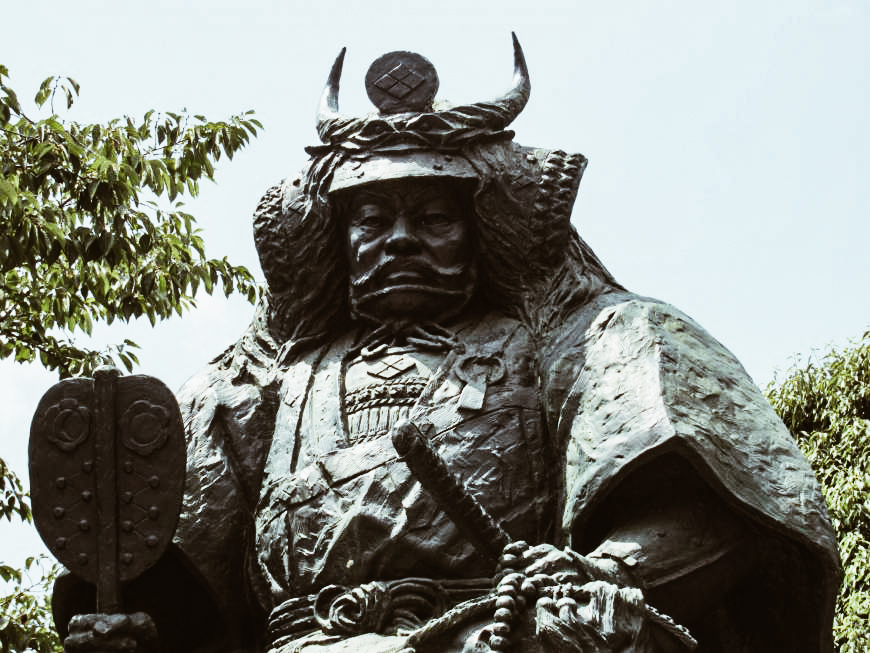
photo credits: japantimes.co.jp
The life of Takeda Shingen
In 1548 Takeda Shingen defeated Ogasawara Nagatoki in the battle of Shiojiritōge and took Fukashi in 1550. Uesugi Kenshin took the field at that time because the Takeda had now reached the borders of his province.
What began was a rivalry that became legendary and that led them to clash in the battles of Kawanakajima. These battles were generally skirmishes, in fact, none of the two daimyō wanted to discover themselves in an all-out battle.
The fiercest battle between the two was the fourth one, during which, according to legend, Uesugi Kenshin managed to break through the Takeda lines and faced Shingen. It is said that Kenshin attacked Shingen with his sword defending himself with his fan (or tessen). Both lost numerous men during the battle. In particular, Shingen lost two important generals, Yamamoto Kansuke and his younger brother Takeda Nobushige.
Takeda Shingen entered the priesthood in 1551, at which time he assumed the Buddhist name Shingen. However, taking religious vows in no way prevented his participation in worldly affairs.
After the fourth battle, Shingen discovered two plots against his life. The first by his cousin Suwa Shigemasa, who was ordered to commit seppuku. While the second, a few years later by his son Takeda Yoshinobu. The latter was exiled to the Toko temple, where he died two years later perhaps by order of his father. After this incident, Shingen appointed his fourth child, Katsuyori as successor to the leadership of the clan.
After conquering Katsurao, Wada, Takashima and Fukuda, in 1554 he returned as many victories in the sieges of Fukushima, Kannomine, Matsuo and Yoshioka.
In 1563, together with Hōjō Ujiyasu, Takeda Shingen conquered Matsuyama Castle in the province of Musashi. Subsequently it obtained the possession of Kuragano in 1565 and of the castle of Minowa. Then he moved against the Hōjō attacking Hachigata castle.
He retired successfully after Hōjō Ujiteru and Hōjō Ujikuni failed to stop him in the battle of Mimasetōge.
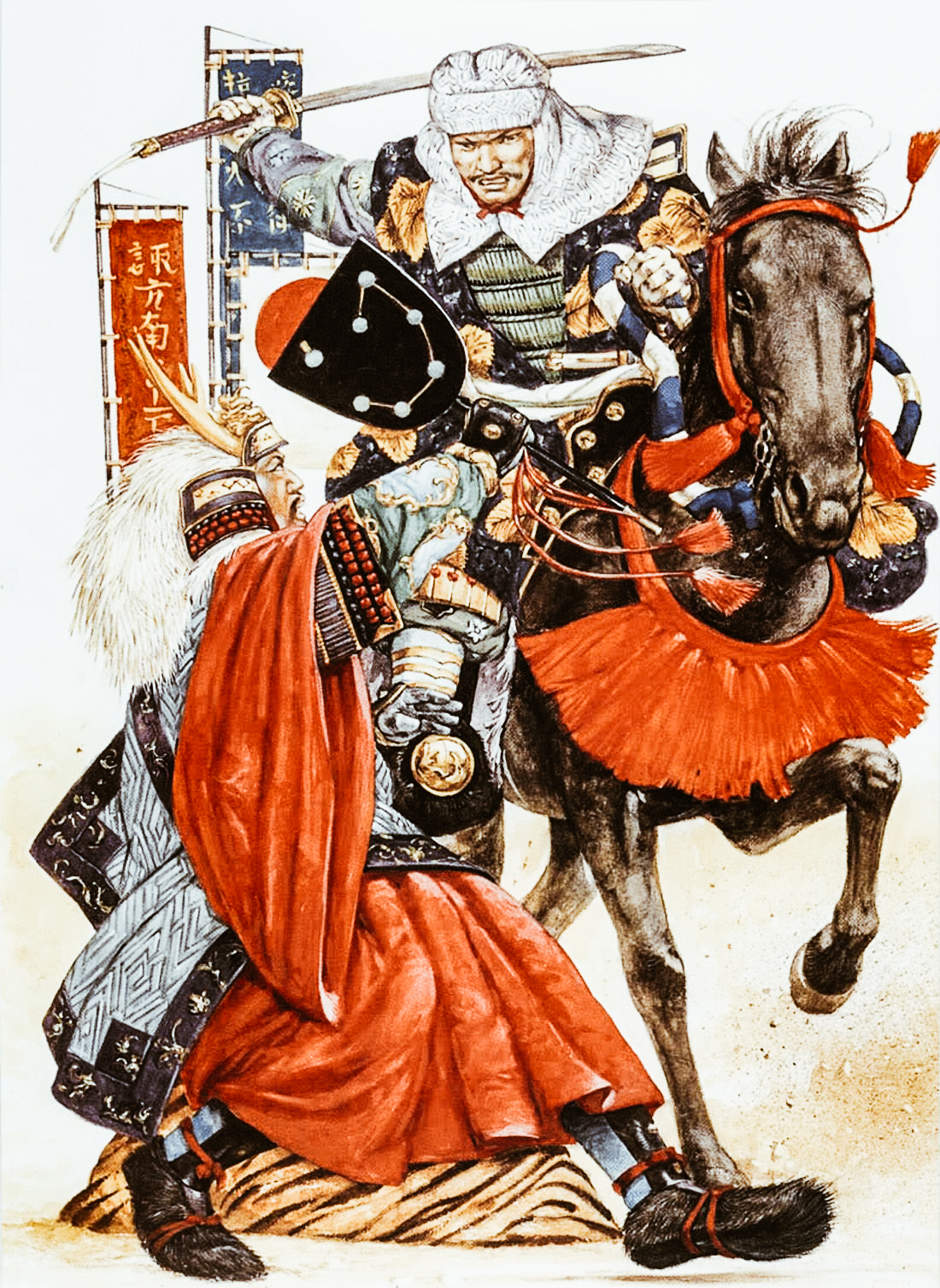
photo credits: pinimg.com
Harunobu's main ambition was the submission of Shinano. However, the resistance in that neighborhood was fierce. A number of Shinano warlords, including Murakami Yoshikiyo, Ogasawara Nagatoki, Suwa Yorishige and Kiso Yoshiyasu, made a move designed with the hope to cut off further Takeda aggressions.
The march towards the Kai borders
In April 1542 the four daimyo combined forces and marched towards the Kai border, encouraged by the news that Harunobu was strengthening his defenses and was preparing to take a stand in Fuchu. In fact, Harunobu's activities were a ploy. Far from passively waiting in Kai, Harunobu led his men and took the Shinano warriors by surprise, defeating them at Sezawa.
Encouraged by Sezawa's findings, Harunobu made a trip to Shinano focusing on the territory of the Suwa clan. He first took Uehara in a surprise attack and then moved to Suwa headquarters in Kuwahara, located 2 kilometers to the east. Suwa Yorishige had no choice but to surrender following Harunobu's promise of safe conduct. Yorishige and his brother were taken to Kai where General Takeda, Itagaki Nobutaka, organized their death. Both of them committed suicide.
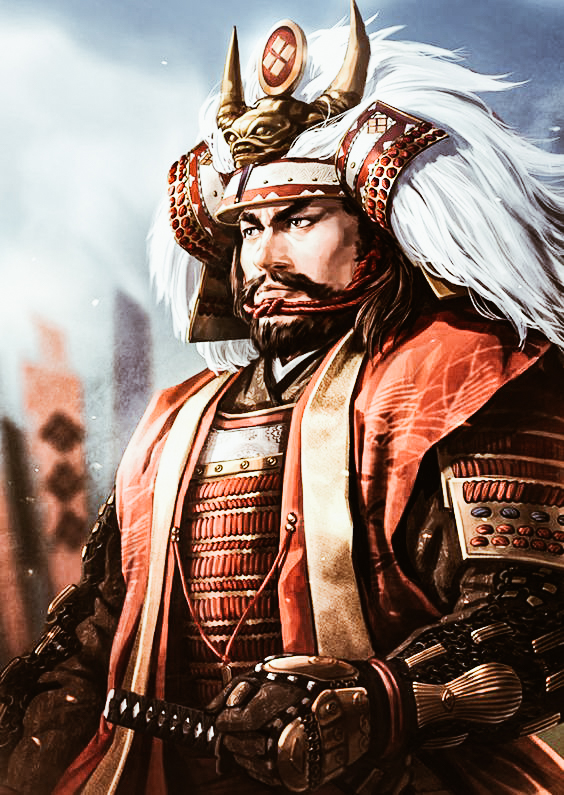
photo credits: pinterest.it
Harunobu, with the help of Yamamoto Kansuke's strategies, further expanded his territory through the defeat of Tozawa Yorichika and Takato Yoritsugu. The acquisition of the castle of Takato was of particular value. Indeed, it provided a safe stopping area in the south of Shinano, as well as a buffer against any southern aggression.
In 1544 the Takeda marched towards Suruga in support of Imagawa and confronted Hōjō Ujiyasu. No real conflict occurred following this confrontation. Harunobu was in fact forced to enter into a peace treaty between Hōjō and Imagawa.
Over the next decade, Harunobu continued to exert incessant pressure on the Shinano warlords. In 1548 Murakami Yoshikiyo, perhaps the most formidable Shinano enemy of Harunobu, moved to Ueda and defeated the Takeda clan in a bitter battle. Here a number of Chinese arquebuses were used, the first weapons of the genre ever deployed in a Japanese battle. While Uehara's defeat left two of his best generals dead, Harunobu quickly bounced back. In fact, in 1552 the Murakami and Ogasawara clans fled from Shinano to Echigo.
Takeda Shingen vs Uesugi Kenshin
In June and October 1553 the Takeda and Uesugi armies clashed near the Kawanakajima plain in northern Shinano. A clash lasted five times but only the fourth battle produced a wide-ranging race. Both sides suffered heavy losses that slowed both warlords for a few years. In particular, Shingen must have suffered from the loss of Nobushige and Yamamoto Kansuke, both of whom died in the battle.
In 1560 Shingen had discovered a plot against him led by his cousin Katanuma Nobumoto and in 1565 the one organized by his son Yoshinobu and Obu Toramasa. Two years later Yoshinbou died. Legend says that death is due either to illness or, as many believe, because Shingen had forced him to commit suicide. The event left Takeda's servants uneasy.

photo credits: wikipedia.org
In 1564, Shingen had subdued all of Shinano and turned his attention to Kōzuke, where he took a number of castles from the Uesugi clan. For the next five years, he limited himself to raids and local conquests, focusing on internal affairs.
In 1560, Shingen's greatest achievement was the Damji River Damming project. The benefit of the Fuji river project is considered one of the greatest national initiatives of the sixteenth century.
In 1568, Takeda's army was on the move again, this time south against Imagawa. The daimyo of that clan was Ujizane, the incompetent son of the late Imagawa Yoshimoto (killed in 1560 by Oda Nobunaga). Yoshinobu, son of Shingen, had married Ujizane's sister, but after her suicide in 1567, relations between the families had increased. It would appear that Shingen and Tokugawa Ieyasu had entered into an agreement under which the two would divide the remaining lands of Imagawa (Tōtōmi and Suruga). However, this agreement was never completed. Furthermore, Sagami's Hōjō did not see this shift in the balance of power. Because of this, he sent troops to challenge Shingen. In 1569 Shingen responded by invading Sagami and besieging Odawara (the capital of Hōjō). However, on the way back to Kai, the Takeda army managed to crush an attempted ambush by Mimasetoge of Hōjō.
Thus, in 1570, the lands of Takeda included Kai, Shinano, Suruga and pieces of Kozuke, Tōtōmi, and Hida. Shingen, at 49, was now more than a regional power. Takeda Shingen was in fact the most important warlord east of Mino. Moreover, he was the only one able to derail Oda Nobunaga's march to national hegemony. Only Shingen had the strategic position and the armed forces to stop it.
In 1570 the formidable Hōjō Ujiyasu died and his heir, Ujimasa, made peace with Shingen. This was an act that could have ensured Tokugawa Ieyasu final destruction. However, Shingen died in 1573 sending the plans into smoke.
The Takeda clan allies with the Oda clan
Meanwhile, the Takeda and Oda, aimed at controlling the Uesugi clan. After a failed diplomatic courtship, they started a war of words with the shogun Ashikaga Yoshiaki.
Shingen intensified the pressure against Tokugawa and in 1572 launched an attack on Tōtōmi which led to the capture of Futamata. The following January, Shingen returned to the province and attracted Tokugawa Ieyasu at the Battle of Mikatagahara. Conducted on January 6 north of Hamamatsu, it ended with an almost complete defeat for Ieyasu.
Although they were often presented as initial moves in a march on Kyoto, Shingen's intentions were undoubtedly more conservative. Probably, Takeda Shingen aimed to test the answers of both Ieyasu and Nobunaga and, if possible, inflict a defeat on the two. In any case, within a few days of winning the battle, he received the news that Asakura Yoshikage had chosen not to oppose to Nobunaga. Shingen was sorry and could count on Yoshikage to maintain the tension on Nobunaga. This may have played a part in his decision to return to Kai, thus granting a truce to the bloody Tokugawa.
The figure of Takeda Shingen
Shingen was a complicated figure, sometimes absolutely cruel. At the beginning of his life, he had forced Suwa Yorishige to commit suicide (or murdered him) after the two warlords had signed a peace treaty. He then took Suwa's daughter as a lover, ignoring the fact that she was technically his own niece.
Apparently, Shingen created Shingen Tsuba, (sword guard) also known as Takeda Tsuba. The story goes that while waiting for a battle to begin, Shingen wrapped the brass wire around a large iron sukashi to keep himself focused and able to think until the battle began. Because of this, many of his vassals followed Shingen's leadership throughout the Edo period.
He is also credited with inventing the toilet drain, bathroom hygiene, apparently, was important to Shingen. He also built the vast dams known as Shingen Zutsumi along the Kamanashi segments of the Fuji river. These walls prevented flooding and were one of the largest and most ambitious national public works initiatives of the sixteenth century.
The well-considered laws of Shingen were not considered particularly severe. He suspended corporal punishment for most minor crimes. In fact, he adopted a system of financial fines, which earned him the respect and praise of the peasants and citizens of the province of Kai.
It is interesting to note that Shingen also had two large iron cauldrons in which to boil criminals still alive. Tokugawa Ieyasu, thinking that the punishment was excessively cruel, destroyed the cauldrons years later.
His economic reform was also innovative at the time. Indeed, Takeda Shingen taxed most of its subjects uniformly and allowed them the option of payments in gold or rice.
Takeda Shingen had planned on the districts of Mikawa and Owari (now both Aichi Prefecture). In 1571 he entered the territories of the Okudaira clan (later Tokugawa) and captured the castle of Noda.
In 1573, he invaded Mikawa and again attacked the castle of Noda. However, this time, the fortifications of the castle had been strengthened, allowing it to stand for several weeks.

photo credits: wikimedia.org
The death
On May 13, 1573, towards the end of the siege, just before the defenders of Noda Castle capitulated, Takeda Shingen was shot by a marksman. Shingen died during the escape.
The death of Takeda Shingen at the age of 49 remained a secret. The remains of the gun that was used to shoot Shingen are kept in the Shitagahara Museum in Nagashino, Aichi Prefecture. His son and successor, Takeda Katsuyori, was defeated by Oda and Tokugawa in the early 1580s, thus ending the power of the Takeda family.
Instead of a poem of death, he left the following words, borrowed from Zen literature: "It is largely left to its natural bodily perfection, and has no special need to resort to artificial coloring and powder to look beautiful. "







